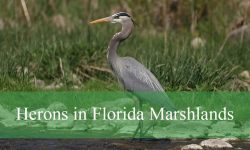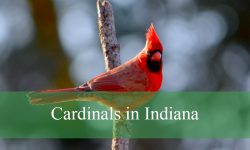I’ve always been fascinated by sparrows — these small, lively birds that seem to bring so much charm and character wherever they appear. There are so many types of sparrows, each with its own unique personality and story. Getting to know them better has become one of my favorite hobbies, and I’m excited to share that passion with you.
When you start exploring the world of sparrows, you quickly realize how diverse they truly are. From the bustling House Sparrow to the rare and beautiful species found in hidden corners of the globe, the variety among the types of sparrows is simply amazing. Each one has distinctive colors, songs, and behaviors that make birdwatching endlessly rewarding.
In this guide, I’ve gathered 60 different types of sparrows with pictures and easy identification tips to help you fall in love with them just like I did. Whether you’re spotting them in your backyard or traveling far and wide, these sparrows will surely capture your heart.
Types of Old World Sparrows (Family: Passeridae)
House Sparrow (Passer domesticus)
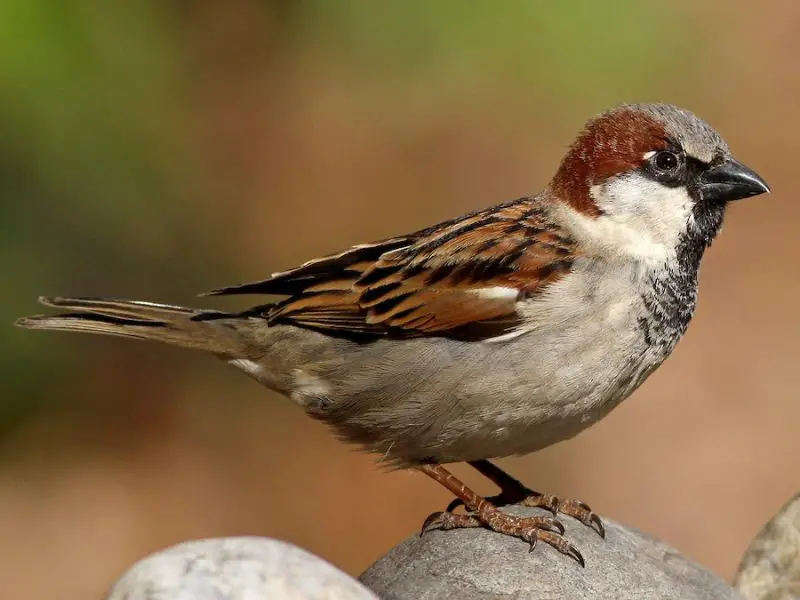
The House Sparrow is a small, stocky bird with a thick bill and short tail, commonly found in urban and suburban areas. Males are recognizable by their gray crown, black bib, and chestnut brown nape, while females are duller with a streaked back and plain face. Their size averages around 6 inches (15 cm), making them one of the most familiar small birds in human environments.
House Sparrows are highly social and often found in noisy flocks around buildings, farms, parks, and cities. They nest in crevices, building eaves, or even inside street signs. These birds are non-migratory and often stay close to where they were born. Their adaptability allows them to thrive in nearly every continent except Antarctica.
Their diet consists mainly of grains, seeds, and crumbs from human food, although they also feed insects to their young during breeding season. One fun fact is that House Sparrows have been recorded using cigarette butts in their nests, possibly as a parasite deterrent.
Eurasian Tree Sparrow (Passer montanus)
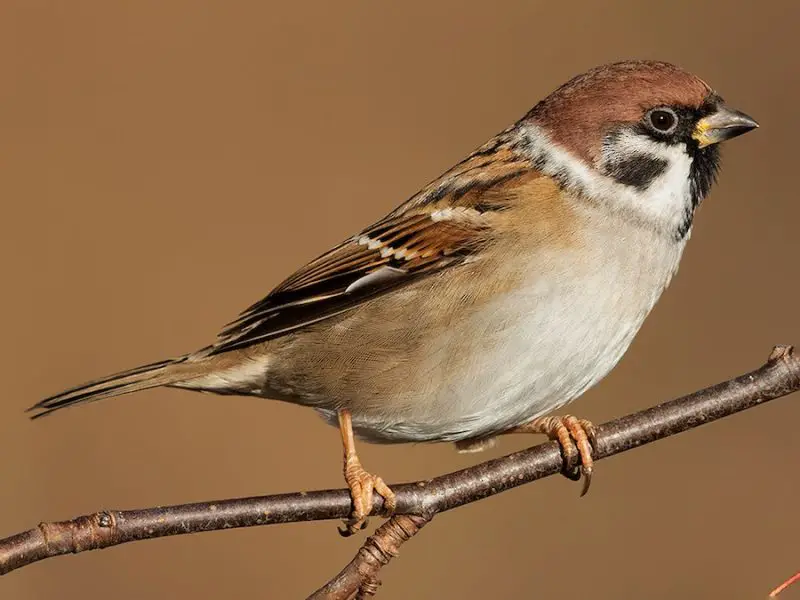
The Eurasian Tree Sparrow is slightly smaller than the House Sparrow and has distinct markings, including a rich chestnut brown crown, black patch on each cheek, and white neck collar. Both sexes look alike, which helps differentiate them from the sexually dimorphic House Sparrow. Their plumage is sleek with black streaking on the back and a grayish belly.
These sparrows are commonly found in rural settings, woodland edges, farmlands, and parks. They prefer quieter environments compared to House Sparrows and often nest in tree cavities, nest boxes, or wall holes. Although native to Europe and Asia, they have been introduced in parts of North America, including the St. Louis area.
Their diet includes seeds, grains, berries, and small insects. They forage both on the ground and in low vegetation. A fun fact about Eurasian Tree Sparrows is that they often form long-term monogamous pair bonds and have been known to cooperatively defend their nesting territories.
Spanish Sparrow (Passer hispaniolensis)
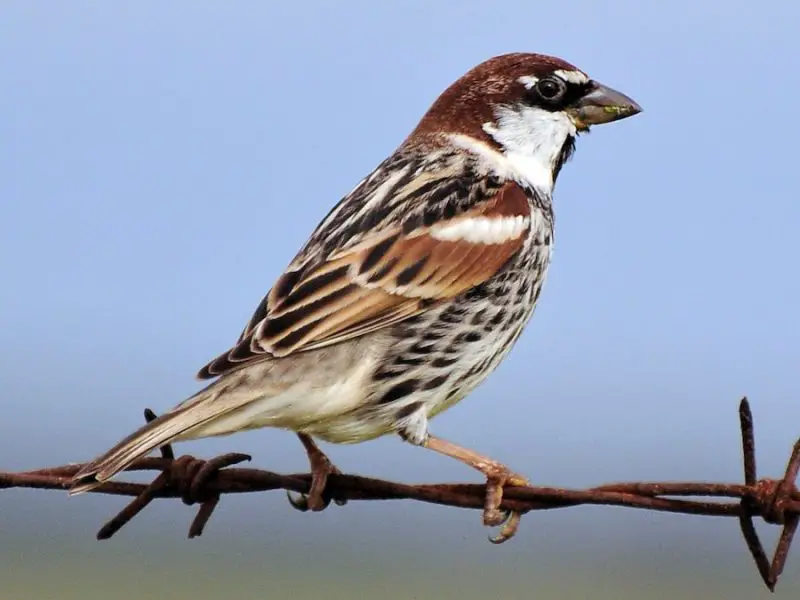
The Spanish Sparrow is a robust and heavily streaked sparrow that resembles the House Sparrow but with noticeable differences. Males have a dark chestnut crown, bold black streaks on a white belly, and a more defined black bib. Females are streaked and brownish, similar to House Sparrow females but generally heavier in appearance.
Spanish Sparrows inhabit southern Europe, North Africa, and parts of western and central Asia. They are often found in open countryside, cultivated areas, reed beds, and sometimes villages, especially where grains and crops are abundant. They may breed in colonies and are known to be semi-nomadic in response to food availability.
Their primary diet consists of seeds and grains, although insects are also consumed during breeding. Spanish Sparrows are known for nesting communally in large, noisy colonies, often in palm trees or dense shrubs. A fun fact is that they sometimes hybridize with House Sparrows, especially in overlapping zones in southern Europe.
Italian Sparrow (Passer italiae)
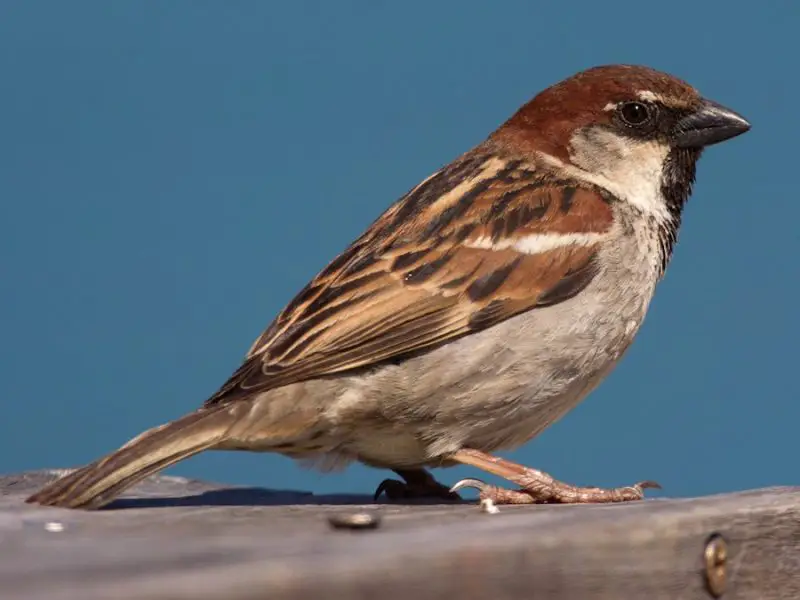
The Italian Sparrow is a hybrid species believed to have originated from a mix between the House Sparrow and the Spanish Sparrow. Males have a chestnut crown, grayish cheeks, and a moderate black bib. Females closely resemble House Sparrow females, making them difficult to distinguish without genetic testing.
This bird is endemic to Italy and nearby islands, with its distribution tightly centered in the Mediterranean. It thrives in human-inhabited areas, including towns, cities, and farmland. Due to its hybrid origins, it displays characteristics of both parent species in behavior and habitat preferences.
Italian Sparrows feed on grains, seeds, and insects, often scavenging near human settlements. They nest in crevices, walls, and trees. A fun fact is that the Italian Sparrow is an example of a stabilized hybrid species, meaning it has established a unique genetic identity and functions as a distinct species rather than a mere hybrid.
Dead Sea Sparrow (Passer moabiticus)
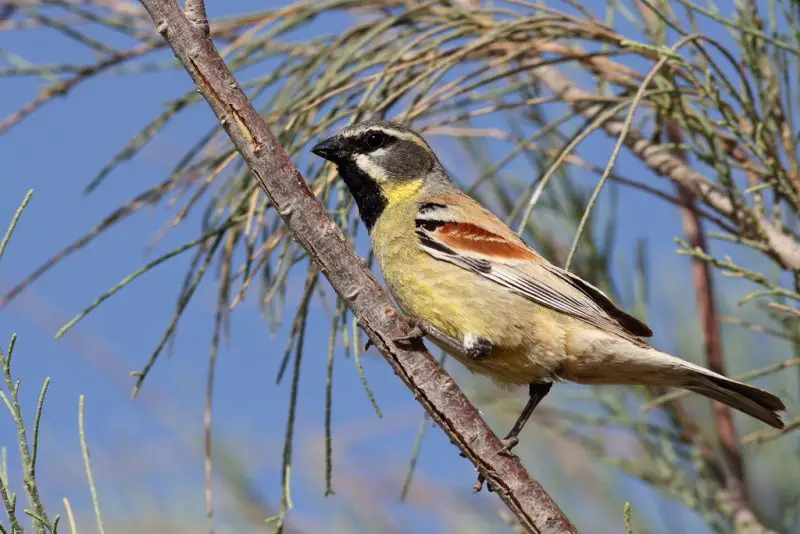
The Dead Sea Sparrow is a small, elegant sparrow with a short tail and fine bill. Males have a pale gray crown, black bib, and yellowish underparts during the breeding season. Females and juveniles are paler and more uniformly colored, making them harder to identify in the field.
These sparrows are found in the arid regions surrounding the Dead Sea, with populations extending into parts of Israel, Jordan, Syria, Iraq, and Iran. They prefer habitats with tamarisk thickets, reed beds, and riverbanks in desert or semi-desert regions. Unlike many sparrows, they are considered shy and elusive.
Dead Sea Sparrows primarily eat seeds and small insects, often gleaned from shrubs or the ground. They nest in low vegetation, sometimes communally, and often return to the same breeding areas year after year. A fun fact about this species is its limited range, which makes it a regional specialty sought after by birdwatchers in the Middle East.
Sind Sparrow (Passer pyrrhonotus)
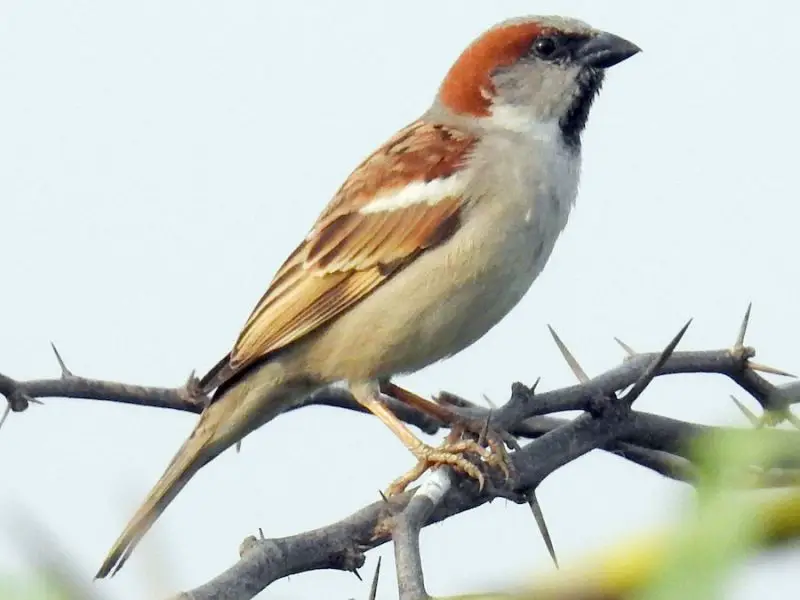
The Sind Sparrow is a small, compact bird characterized by its pale brown back, grayish head, and buffy underparts. Males have a faint gray crown and a small black bib, while females are duller overall and resemble House Sparrow females but are generally more delicate in appearance. The species measures around 13 cm in length.
Native to the Indus Valley region, the Sind Sparrow inhabits riverine forests, reed beds, and cultivated fields near water bodies in Pakistan and northwestern India. It prefers warm, lowland environments and is often found nesting in dense bushes and tall grasses. Unlike urban-adapted sparrows, this species stays closer to natural habitats.
Its diet consists mainly of seeds and small insects, particularly during the breeding season. They are active foragers and often seen in pairs or small flocks. A fun fact is that the Sind Sparrow was once considered a subspecies of the Plain-backed Sparrow but is now recognized as a distinct species due to differences in plumage and distribution.
Russet Sparrow (Passer cinnamomeus)
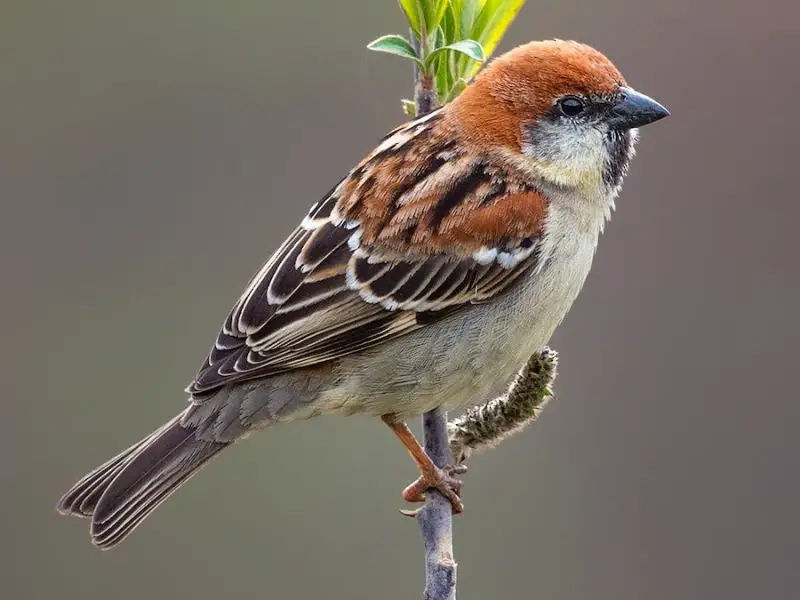
The Russet Sparrow is a striking bird with warm chestnut-colored plumage covering its head and back. Males have black around the eyes and a black bib, while females are more subdued, with a gray-brown body and less conspicuous markings. This species is about the same size as the House Sparrow but has a more vivid appearance in males.
It is commonly found in the foothills of the Himalayas, parts of Southeast Asia, and China. The Russet Sparrow favors open woodlands, villages, and farmlands, especially in mountainous or hilly regions. It is less dependent on urban areas compared to its more cosmopolitan relatives.
Feeding primarily on grains and seeds, it also consumes insects during breeding season. Russet Sparrows nest in tree holes, crevices, or under roof tiles. A fun fact is that in many parts of Asia, especially in Nepal and Bhutan, this sparrow is considered a symbol of good luck and happiness.
Plain-backed Sparrow (Passer flaveolus)
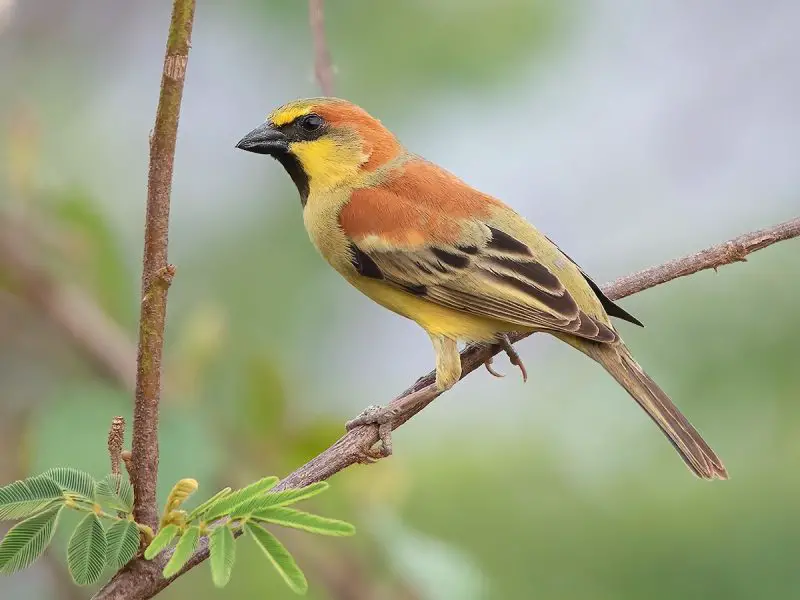
The Plain-backed Sparrow is easily recognized by its yellowish-buff back and lighter underparts, giving it a more uniform appearance than most sparrows. Males have a reddish crown and a small black bib, while females are pale and lack distinctive markings, making them harder to identify.
This species is native to Southeast Asia, particularly in countries like Thailand, Laos, Cambodia, and Vietnam. It prefers open grasslands, agricultural lands, and lightly wooded areas near villages. Unlike the more adaptable House Sparrow, it is more restricted to warm lowland habitats.
It feeds on grass seeds, grains, and small insects. These sparrows are known to form monogamous pairs and nest in small colonies, often in trees or shrubs near cultivated fields. A fun fact is that their plain coloration serves as excellent camouflage in dry, grassy environments where they forage.
Kenya Rufous Sparrow (Passer rufocinctus)
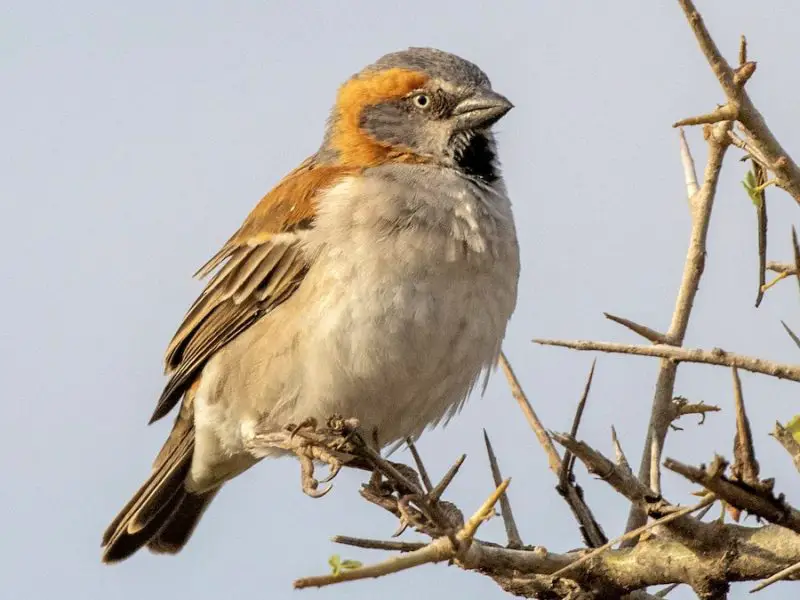
The Kenya Rufous Sparrow is a medium-sized sparrow with rich rufous coloration on the head, nape, and back. Males have a clear contrast between their chestnut upperparts and grayish underparts, while females are paler with more streaked brown tones. Both sexes have a sturdy bill adapted for seed consumption.
Endemic to parts of East Africa, particularly in Kenya and northern Tanzania, this sparrow inhabits dry savannas, open woodlands, and sometimes suburban gardens. It avoids dense forests and instead favors areas with scattered trees and shrubs. This species tends to remain local but may wander slightly based on food availability.
Its diet includes seeds, grains, and occasional insects. The Kenya Rufous Sparrow is known for its strong pair bonds and typically nests in tree hollows or thick bushes. A fun fact is that it was once lumped with other rufous sparrows in Africa but is now considered a separate species due to distinct vocalizations and plumage patterns.
Northern Grey-headed Sparrow (Passer griseus)
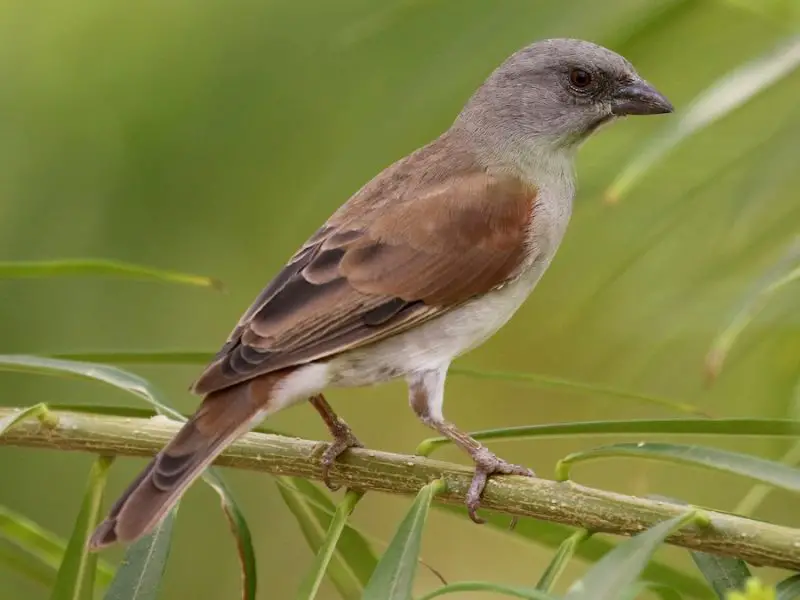
The Northern Grey-headed Sparrow is a sleek bird with a plain gray head, chestnut back, and pale underparts. Males and females look similar, though males often have a slightly darker head and a faint black line near the bill. It closely resembles the Southern Grey-headed Sparrow but is found in a different region.
This species is widespread across sub-Saharan Africa, especially in West and Central Africa. It is commonly seen in open country, villages, farmlands, and savannas. It is quite comfortable around humans and often nests on buildings, trees, and even utility poles.
Its diet consists mainly of seeds, fruits, and insects, with a preference for millet and cultivated grains. The Northern Grey-headed Sparrow is a sociable bird, often seen in small groups or family flocks. A fun fact is that they often engage in communal roosting, with dozens of birds huddling together in trees at night for warmth and protection.
Swainson’s Sparrow (Passer swainsonii)
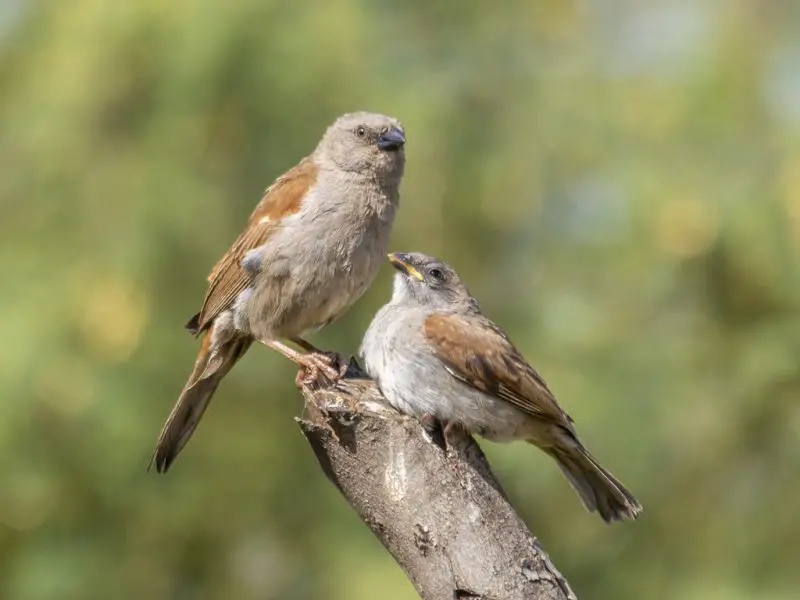
Swainson’s Sparrow is a medium-sized African sparrow with relatively plain brown plumage and a grayish head. Males have a dark bill and slightly darker plumage on the upperparts, while females are duller and lack strong markings. They resemble the House Sparrow but are more uniformly colored and have a slightly more slender build.
This species is found primarily in the highlands of Ethiopia and Eritrea, thriving in dry scrublands, agricultural fields, and even urban areas. It often replaces the House Sparrow in these regions, occupying similar ecological niches and coexisting with human activity. Swainson’s Sparrow tends to be non-migratory and locally abundant.
Its diet consists of seeds, grains, and insects, particularly during the breeding season. These sparrows nest in buildings, tree cavities, or even cliff crevices. A fun fact is that Swainson’s Sparrow has adapted so well to Ethiopian cities that it is often seen hopping along roadsides and feeding near marketplaces.
Sudan Golden Sparrow (Passer luteus)
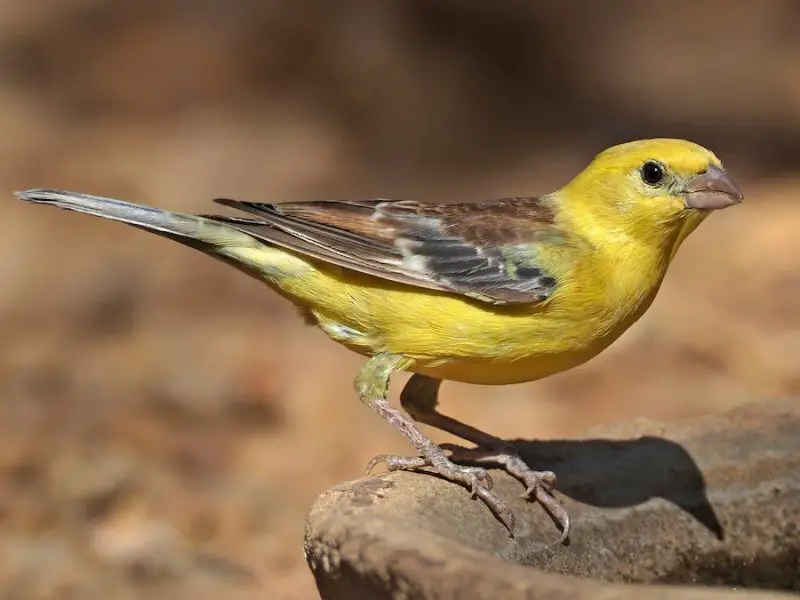
The Sudan Golden Sparrow is a striking and colorful bird, especially the male, which displays vibrant golden-yellow plumage with black around the eyes and bill. Females and juveniles are paler, with yellowish underparts and sandy upperparts, giving them a soft, warm appearance that blends with desert environments.
This sparrow is native to the Sahel region of Africa, including countries like Sudan, Chad, Mali, and Niger. It inhabits dry savannas and arid shrublands, often near water sources or human settlements. It is highly gregarious and frequently forms large flocks, especially during the non-breeding season.
Feeding mainly on grass seeds, the Sudan Golden Sparrow forages on the ground and often joins other finches and sparrows. A fun fact is that this species is known for its elaborate and tightly packed colony nests, where hundreds of individuals may nest side-by-side in large acacia trees, creating a bustling community.
Chestnut Sparrow (Passer eminibey)
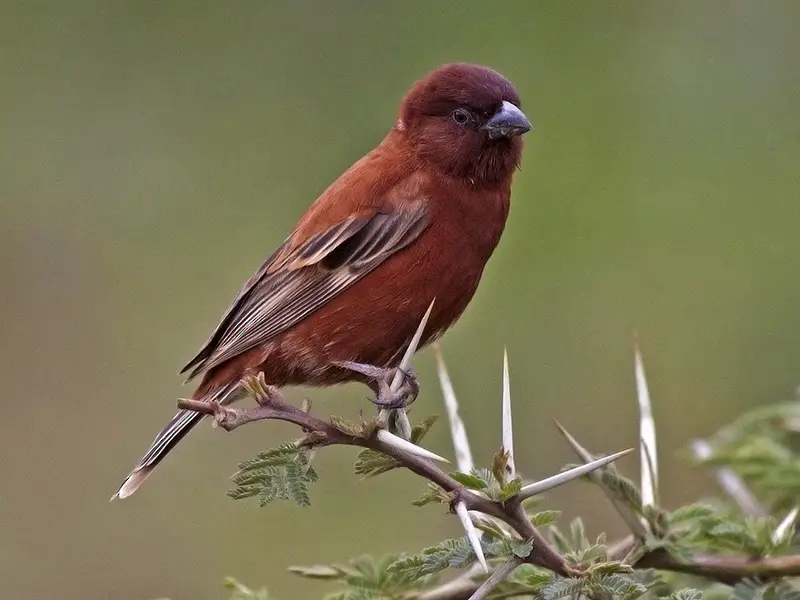
The Chestnut Sparrow is a compact and richly colored bird, with adult males showing a deep chestnut head and body contrasted with a black face and bib. Females and immatures are brownish and streaked, resembling other African sparrows but with a more subdued chestnut hue on the back and wings.
It is found across parts of East and Central Africa, including Sudan, Kenya, Uganda, and Ethiopia. This species prefers savanna woodlands, grasslands, and cultivated areas, often near human settlements. Chestnut Sparrows are known to associate with weaver bird colonies, sometimes taking over their nests.
Its diet consists of grass seeds and grains, with occasional insects. These sparrows are communal and often nest in groups, forming tight-knit colonies. A fun fact is that male Chestnut Sparrows engage in synchronized courtship displays by fluffing their feathers and chirping together—a unique behavior that enhances mating success.
Iago Sparrow (Passer iagoensis)
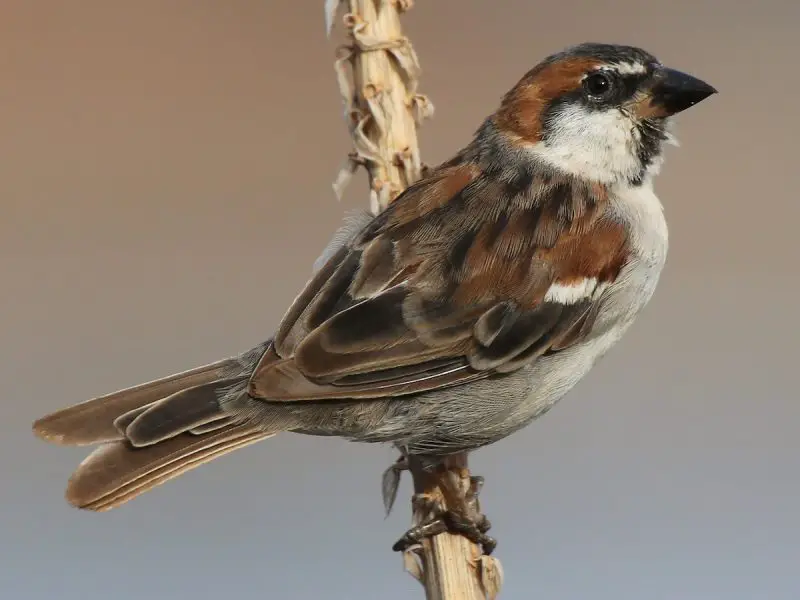
The Iago Sparrow is a small, attractive sparrow native to the Cape Verde Islands. Males have a black throat and upper breast, gray crown, and chestnut nape, while females are more muted, with buffy underparts and brown-streaked backs. It resembles the House Sparrow but is slightly smaller and has a more slender profile.
This island-endemic species inhabits dry, rocky landscapes, coastal scrublands, and human settlements across the Cape Verde archipelago. It is non-migratory and highly adapted to arid island environments, often seen hopping along rocky ground in search of food.
Iago Sparrows feed on a mix of seeds, small fruits, and insects. They build nests in rock crevices, buildings, or under roof tiles, often reusing the same sites year after year. A fun fact is that despite its isolated island range, the Iago Sparrow is surprisingly tame and frequently interacts with people in villages and towns.
Somali Sparrow (Passer castanopterus)
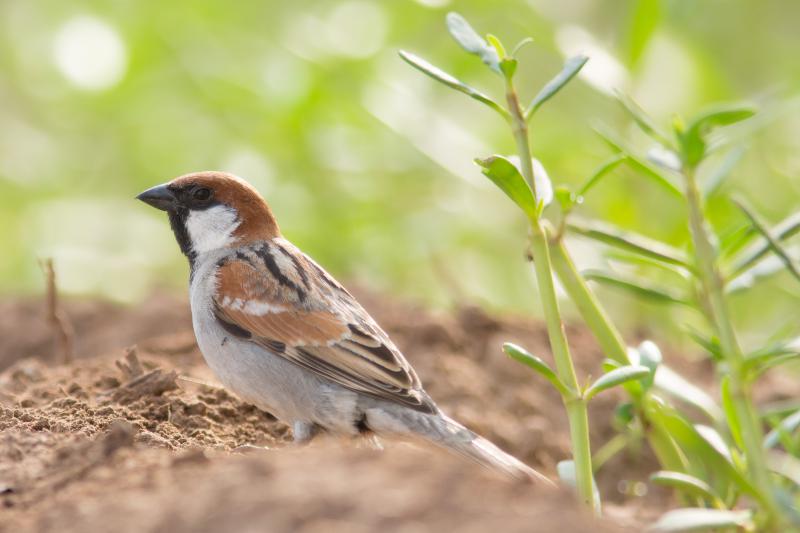
The Somali Sparrow is a medium-sized sparrow with distinct chestnut-brown wings and back, contrasting with its gray head and pale underparts. Males show richer colors and a small black throat patch, while females are duller with more uniform plumage. Their overall appearance is sleek and well-adapted to arid landscapes.
This species is native to the Horn of Africa, particularly Somalia, Djibouti, and eastern Ethiopia. It inhabits dry savannas, thorn scrub, and arid plains, often staying close to waterholes or sparsely vegetated regions. It is a localized species with a relatively limited distribution.
Somali Sparrows primarily feed on grass seeds and occasionally small insects, foraging on the ground or low shrubs. They are typically seen in pairs or small flocks and nest in trees or bushy vegetation. A fun fact is that this species was once grouped with the Rufous Sparrow complex but is now recognized as distinct due to its range and subtle morphological differences.
Cape Sparrow (Passer melanurus)
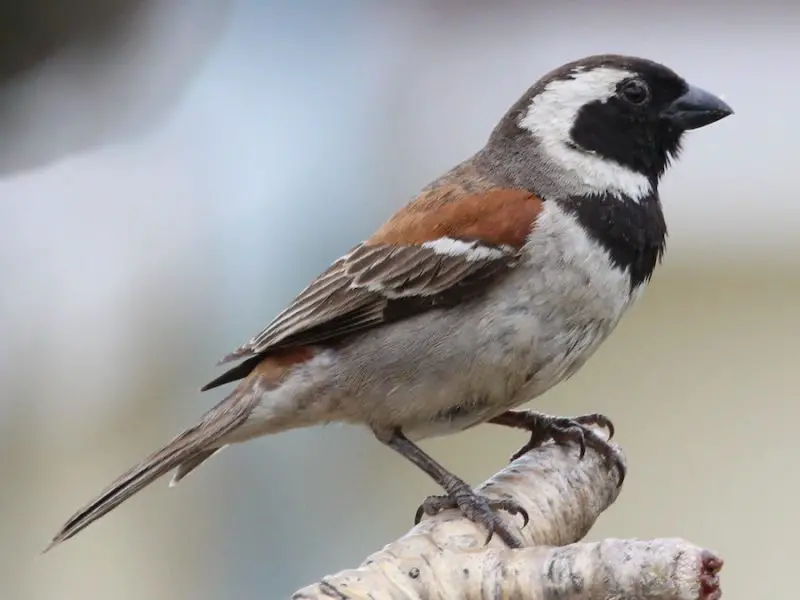
The Cape Sparrow is a striking and easily recognizable species found in southern Africa. Males display a bold black head, white cheeks, and a chestnut-colored nape, while females and juveniles are more muted with grayish heads and brown upperparts. The male’s strong contrast in plumage makes it easy to distinguish from other sparrows in its range.
This sparrow is native to South Africa, Namibia, Botswana, and Lesotho, where it thrives in arid shrublands, open grasslands, agricultural fields, and urban gardens. It is a non-migratory bird that often forages in pairs or small flocks and is comfortable living near human settlements. Cape Sparrows nest in cavities, trees, and even man-made structures.
Their diet includes seeds, grains, and insects, particularly during the breeding season. Cape Sparrows are social and vocal, often forming loose colonies. A fun fact is that they have adapted exceptionally well to urban environments and can frequently be seen around outdoor cafés or feeding on lawn seed in suburban neighborhoods.
Great Sparrow (Passer motitensis)
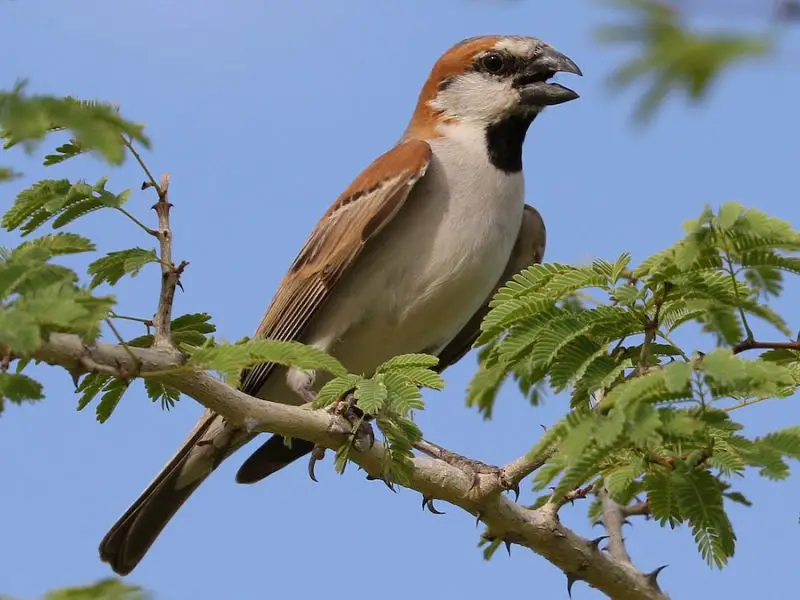
The Great Sparrow is a large and robust species with warm rufous-brown upperparts and a broad gray crown. Males have a black throat and upper breast, while females are plainer with buffy underparts and less distinct markings. It resembles the House Sparrow but is larger and has more vibrant plumage.
It is found in dry savannas and bushy regions of southern Africa, including parts of Namibia, Botswana, Zimbabwe, and South Africa. This bird prefers open woodlands and semi-arid zones and avoids dense forests or very wet regions. Great Sparrows are relatively shy and not as urban-adapted as some of their relatives.
Their diet consists mainly of seeds and grains, but they also eat insects during the breeding season. They nest in tree cavities or use abandoned nests of other birds. A fun fact is that the Great Sparrow’s scientific name “motitensis” was derived from the town of Motito in Botswana, where early specimens were first collected.
Parrot-billed Sparrow (Passer gongonensis)
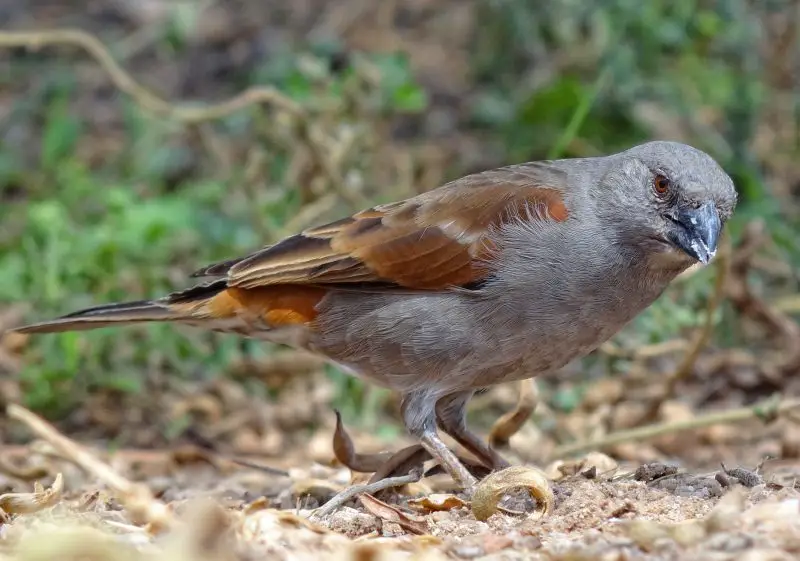
The Parrot-billed Sparrow gets its name from its unusually large and powerful bill, which is thick and curved like that of a parrot. Males and females have similar plumage—generally brown above with streaking, pale underparts, and a grayish head—though males are slightly bolder in color.
This species is native to eastern Africa, especially found in areas of Ethiopia, Kenya, Uganda, and Tanzania. It inhabits dry savannas, thorn scrub, and cultivated areas, particularly in lowland regions. The large bill helps it crack open tough seeds and grains, making it well-suited to arid environments with sparse vegetation.
It feeds on a variety of hard seeds, grains, and some insects, often foraging on the ground. Parrot-billed Sparrows are generally found in small groups and sometimes associate with other seed-eating birds. A fun fact is that the Parrot-billed Sparrow was once considered a subspecies of the Sudan Golden Sparrow but is now recognized as a distinct species based on its bill size and behavior.
Southern Grey-headed Sparrow (Passer diffusus)
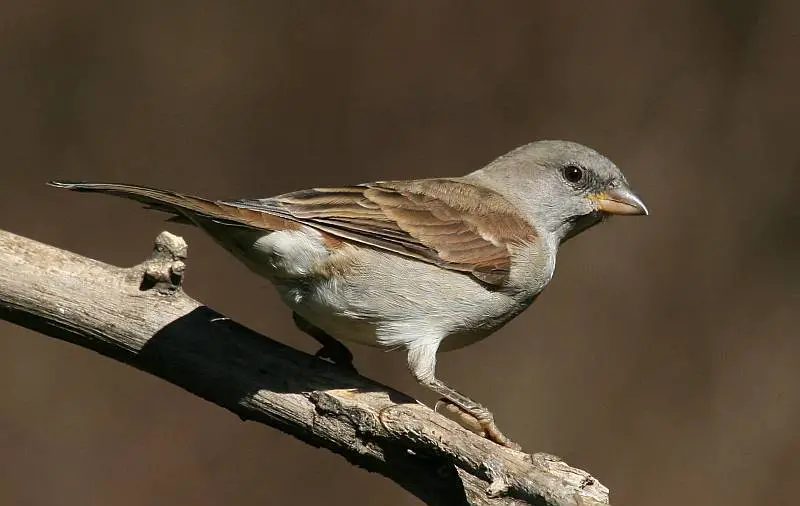
The Southern Grey-headed Sparrow is a sleek bird with a clean gray head, pale underparts, and brown wings and back. Males and females look similar, though males may show a slightly darker bib during the breeding season. This sparrow is part of a complex of closely related grey-headed species found across Africa.
It is widespread throughout southern Africa, including countries like South Africa, Namibia, Mozambique, Zimbabwe, and Eswatini. This bird favors savannas, gardens, open woodlands, and suburban areas. It is often found perched on fences or telephone wires and is quite tolerant of human activity.
Its diet includes seeds, fruit, and small insects, which it forages mostly on the ground. These sparrows are monogamous and nest in tree hollows, nest boxes, or building crevices. A fun fact is that the Southern Grey-headed Sparrow often forms mixed feeding flocks with weavers and other sparrows, creating a lively scene in rural areas.
Kordofan Sparrow (Passer cordofanicus)

The Kordofan Sparrow is a relatively localized and lesser-known species distinguished by its subtle plumage. It resembles the House Sparrow but is slightly paler and more uniformly colored. Males have a gray crown and nape with a small black bib, while females are plain brown with minimal streaking and a paler underside.
This sparrow is endemic to the Kordofan region of western Sudan, where it inhabits dry savannas, open scrublands, and villages. Its range is quite restricted, and it often occurs near human habitations, blending seamlessly with the rural landscape. It is considered part of the “rufous sparrow” complex, though it maintains its own distinct population.
Kordofan Sparrows feed primarily on seeds, small grains, and insects. They forage in open fields or near granaries and often nest in thatched roofs or mud walls of local dwellings. A fun fact is that this species was historically lumped with the African Rufous Sparrow but is now treated as separate due to slight differences in plumage and vocalization.
Desert Sparrow (Passer simplex)
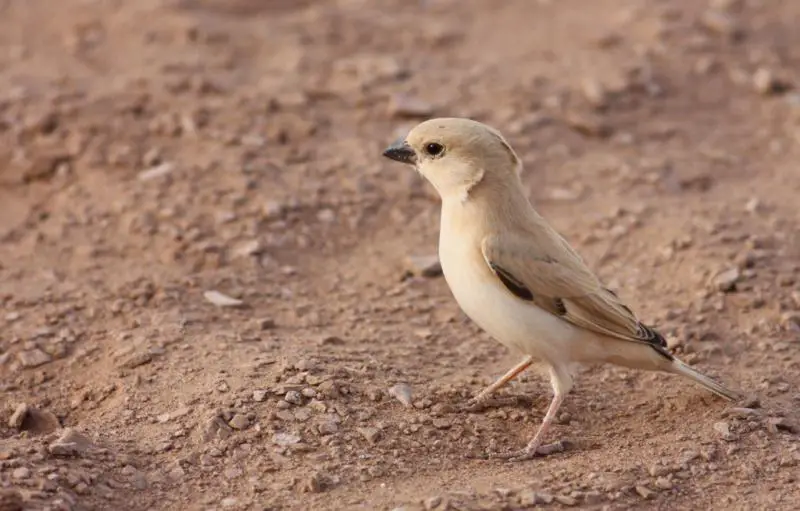
The Desert Sparrow is a beautiful, pale-colored bird perfectly adapted to harsh desert climates. Males are soft sandy-gray with a distinctive black patch on the throat and around the eyes, giving a masked appearance. Females lack the black markings and have a more uniformly sandy-brown coloration. Both sexes have a slender, elegant look suited for desert life.
This species is found across the Sahara Desert and parts of the Sahel, including countries like Morocco, Algeria, Mali, and Mauritania. It inhabits true desert environments—sand dunes, dry wadis, and scattered oases—often nesting in remote areas with few other bird species. Despite the extreme conditions, the Desert Sparrow has managed to thrive in isolated pockets.
Its diet consists of dry seeds, small grains, and occasionally insects when available. It nests in holes within mud walls or under rocks and sometimes uses abandoned swallow nests. A fun fact is that the Desert Sparrow is so revered in Saharan cultures that it has been featured in Berber poetry and folklore as a symbol of survival and serenity in the desert.
Abd al-Kuri Sparrow (Passer hemileucus)
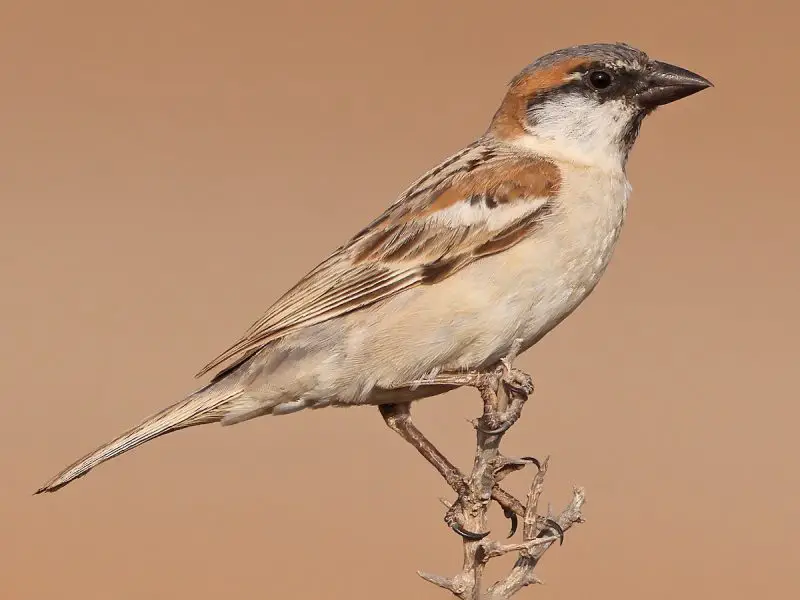
The Abd al-Kuri Sparrow is a rare and island-endemic species that exhibits a unique mix of sparrow characteristics. Males are brown above with grayish underparts and have distinctive white wing patches, while females are more subdued in color. Both sexes are compact and sturdy, with a short, thick bill adapted for seed eating.
This sparrow is restricted to the tiny island of Abd al-Kuri, part of the Socotra archipelago in the Arabian Sea. The island is remote and sparsely vegetated, consisting mostly of rocky terrain and dry scrub. The sparrow’s limited range makes it highly vulnerable to environmental changes and human disturbance.
It feeds mainly on grass seeds, small invertebrates, and plant material, often foraging on the ground or among low shrubs. The species nests in rock crevices and small cliff ledges, making use of the island’s rugged terrain. A fun fact is that this sparrow is considered one of the rarest passerines in the world, and its isolation has led to several unique behavioral and ecological traits not found in mainland species.
Types of New World Sparrows (Family: Passerellidae)
Song Sparrow (Melospiza melodia)
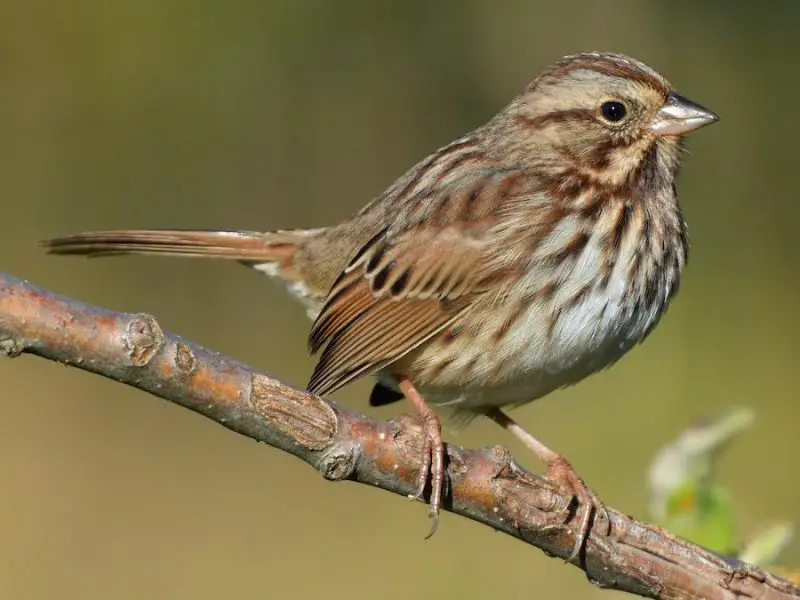
The Song Sparrow is one of North America’s most widespread and recognizable sparrows, known for its rich and melodious song. It has streaky brown upperparts, a heavily streaked breast with a central dark spot, and a rounded head with a grayish eyebrow. Its plumage can vary by region, with darker birds found in wetter areas and paler birds in arid zones.
This species inhabits a broad range across the United States, Canada, and parts of Mexico. Song Sparrows prefer brushy habitats near water, forest edges, suburban gardens, and wetlands. They are highly adaptable and can thrive in both rural and urban environments. Their behavior is often secretive, hopping low through vegetation or singing from a concealed perch.
Song Sparrows feed on seeds, insects, and berries, foraging mostly on the ground or in low shrubs. They are year-round residents in milder climates and migrate short distances in colder regions. A fun fact is that male Song Sparrows develop unique, individualized songs within their territory, which helps them distinguish neighbors from strangers.
White-throated Sparrow (Zonotrichia albicollis)
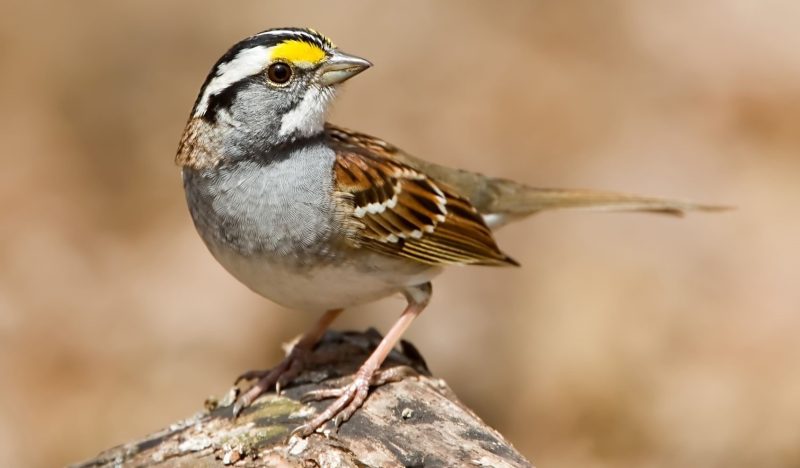
The White-throated Sparrow is a striking bird with bold facial markings and a pure white throat bordered by dark lateral stripes. There are two color morphs: white-striped and tan-striped, both having a yellow spot between the eye and bill. Its underparts are grayish, and the back is streaked brown.
It breeds in the boreal forests of Canada and the northeastern United States and migrates to the southeastern U.S. for winter. This sparrow prefers woodlands, thickets, and forest edges with dense underbrush. During migration and winter, it is a familiar visitor to backyard feeders and brush piles.
Its diet consists of seeds, fruits, and insects, and it often scratches at the ground in search of food. Males are known for their clear whistled song, often interpreted as “Oh sweet Canada, Canada, Canada.” A fun fact is that recent studies show these sparrows are evolving their song structure, with a new dialect spreading across their range.
White-crowned Sparrow (Zonotrichia leucophrys)
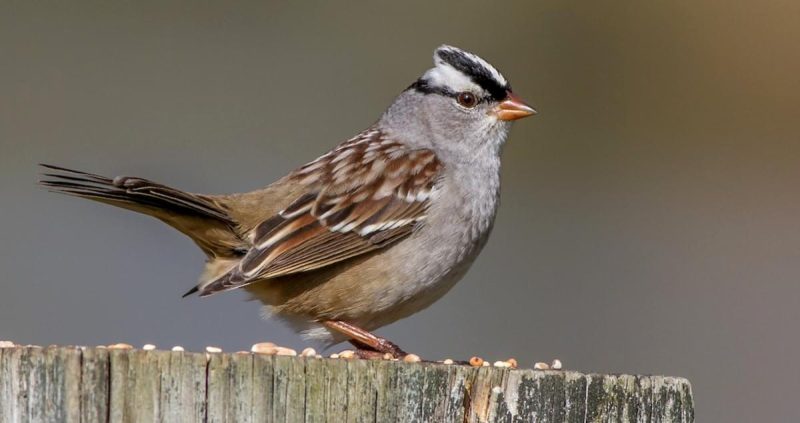
The White-crowned Sparrow is easy to identify by its bold black-and-white striped head, gray face and breast, and brown-streaked back. Juveniles have tan and brown crown stripes instead of the black-and-white seen in adults. Its clean and crisp appearance makes it a favorite among birdwatchers.
This species breeds in northern Canada and the Arctic and migrates to the southern U.S. and Mexico during winter. It prefers tundra, alpine meadows, shrublands, and coastal thickets, but in winter, it is often seen in open fields, weedy roadsides, and gardens. It is a ground-forager and often hops or runs with its tail held up.
White-crowned Sparrows eat seeds, buds, and insects, scratching through leaf litter to uncover food. They have a distinctive whistled song that varies by geographic region, functioning like a regional “accent.” A fun fact is that young sparrows learn their local dialect by listening to older males, showing cultural transmission in birds.
Fox Sparrow (Passerella iliaca)
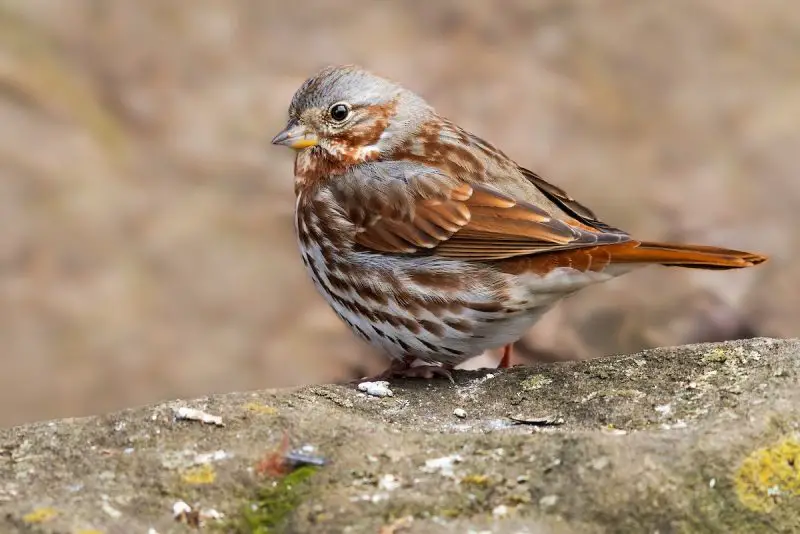
The Fox Sparrow is a large, chunky sparrow with heavy breast streaking and rich rufous tones throughout its body. It has a gray head, bright reddish tail, and bold streaks that merge into a central breast spot, giving it a powerful and colorful appearance. The name “Fox Sparrow” comes from its fox-like reddish-brown coloring.
It breeds in remote boreal forests and mountain habitats across Alaska, Canada, and parts of the northwestern U.S., migrating to southern states during winter. Fox Sparrows are shy and secretive, often seen scratching vigorously in leaf litter under dense vegetation in forested or shrubby areas.
Their diet consists mainly of seeds, berries, and insects. They are known for their beautiful, clear, and melodious song, which is often described as one of the loveliest of all sparrows. A fun fact is that the Fox Sparrow is actually a group of four distinct regional forms, which some ornithologists believe may eventually be classified as separate species.
Lincoln’s Sparrow (Melospiza lincolnii)
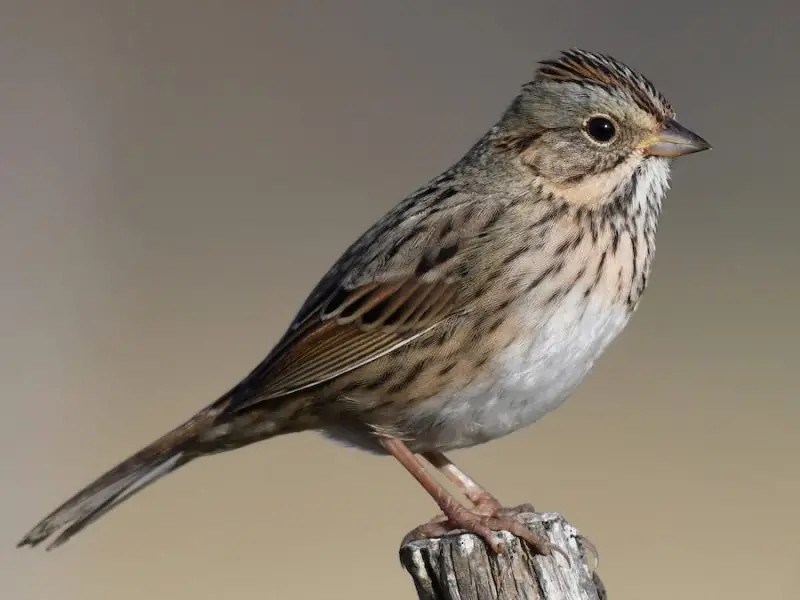
Lincoln’s Sparrow is a small and delicately marked bird known for its buffy breast, fine dark streaking, and a neatly crested head. Its gray face with a thin eye ring gives it a gentle and somewhat shy expression. Though similar to the Song Sparrow, it is more finely detailed and less boldly marked.
This species breeds in the boreal forests and wet meadows of Canada and the northern U.S., and winters in the southern U.S., Mexico, and parts of Central America. It favors dense vegetation near water, such as bogs, brushy edges, or shrubby wetlands, and is often difficult to see due to its secretive nature.
Lincoln’s Sparrows feed on insects during the breeding season and switch to seeds in winter. They forage low to the ground or in thick cover, rarely venturing far into the open. A fun fact is that its song is a beautiful, gurgling warble—surprisingly complex for such an inconspicuous bird—leading some to call it a “hidden vocalist” of the marshes.
Swamp Sparrow (Melospiza georgiana)
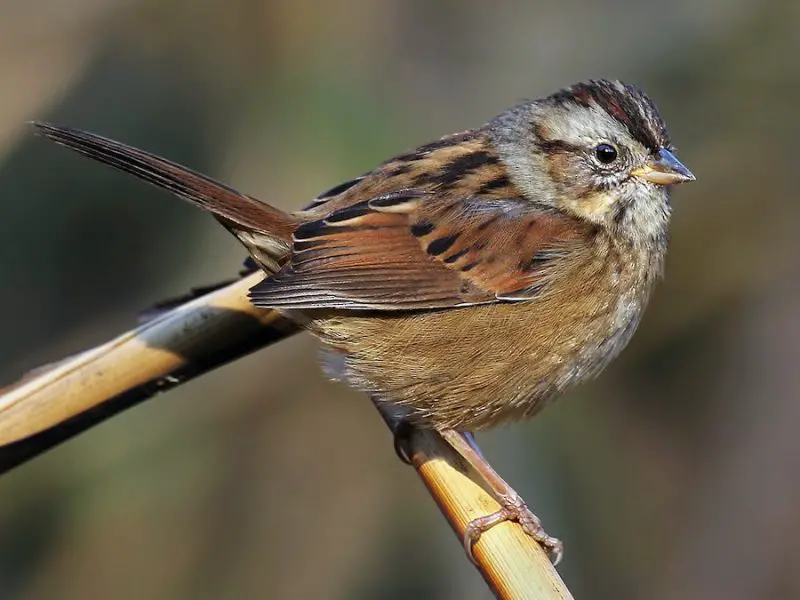
The Swamp Sparrow is a medium-sized bird with a round body, rusty wings, and a gray face accented by a dark crown and eye line. Its breast is mostly unstreaked and lightly washed with gray or buff, while the back and wings show rich rufous tones. In winter, its colors appear slightly duller, aiding in camouflage among wetland vegetation.
This species inhabits freshwater and brackish marshes, wet meadows, and swampy thickets, particularly in eastern and central North America. During the breeding season, Swamp Sparrows favor cattail marshes and bogs, while in winter, they can be found in brushy wetlands and coastal marshes. They are secretive and prefer dense cover, often heard before being seen.
Swamp Sparrows feed primarily on insects and other invertebrates during summer and shift to seeds and plant matter in winter. They forage by walking or hopping through wet ground and low vegetation. A fun fact is that their song is a simple, slow trill, which can often be heard echoing over marshlands early in the morning or at dusk.
Savannah Sparrow (Passerculus sandwichensis)
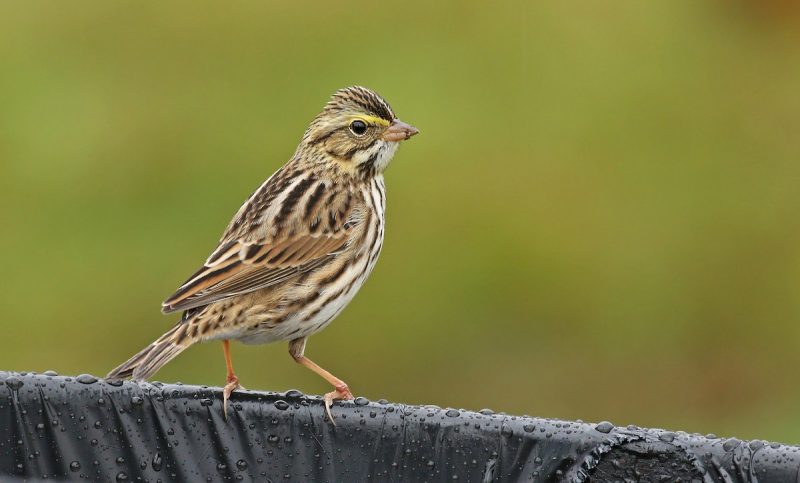
The Savannah Sparrow is a small, streaky sparrow with a distinctive yellowish patch in front of the eye and a short, notched tail. Its body is covered in brown and white streaks, and the overall look may vary slightly depending on the region. Despite its name, it is not limited to savannahs but occupies a wide variety of open habitats.
This adaptable bird ranges across most of North America, breeding in grassy fields, coastal meadows, tundra edges, and even alpine zones. In winter, it migrates to the southern United States, Mexico, and parts of Central America. Savannah Sparrows often perch on fences and low shrubs and forage on the ground in open terrain.
They feed on a mixture of seeds and insects, foraging by walking or hopping in short grass or agricultural fields. A fun fact is that some subspecies, like the “Ipswich Sparrow,” breed exclusively on Sable Island in Nova Scotia and are notably paler than their mainland counterparts, showcasing remarkable geographic variation.
Grasshopper Sparrow (Ammodramus savannarum)
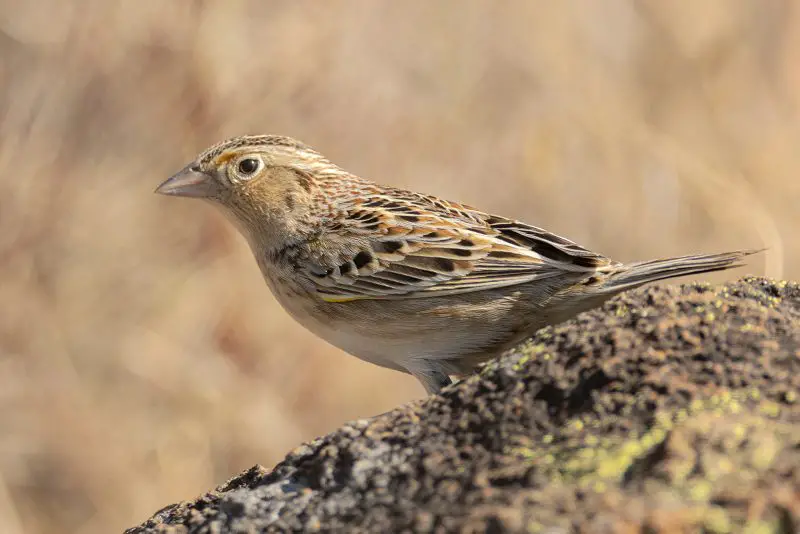
The Grasshopper Sparrow is a small, flat-headed sparrow with a large bill, short tail, and buff-colored chest. It has a plain face with a pale central crown stripe and a somewhat subdued appearance. Its name comes from its high-pitched, insect-like song, which resembles the stridulations of a grasshopper.
Grasshopper Sparrows prefer dry, open grasslands, prairies, and old fields across North America. They are ground-dwelling birds that favor areas with a mix of bare soil and grasses. These sparrows are especially sensitive to habitat fragmentation and loss, making them an important species for grassland conservation efforts.
Their diet consists mostly of grass seeds and insects, especially grasshoppers and crickets during the breeding season. They build their nests on the ground, often under a clump of grass. A fun fact is that despite being secretive and inconspicuous, males perform a fluttering “song flight” display during courtship to attract females.
Henslow’s Sparrow (Centronyx henslowii)
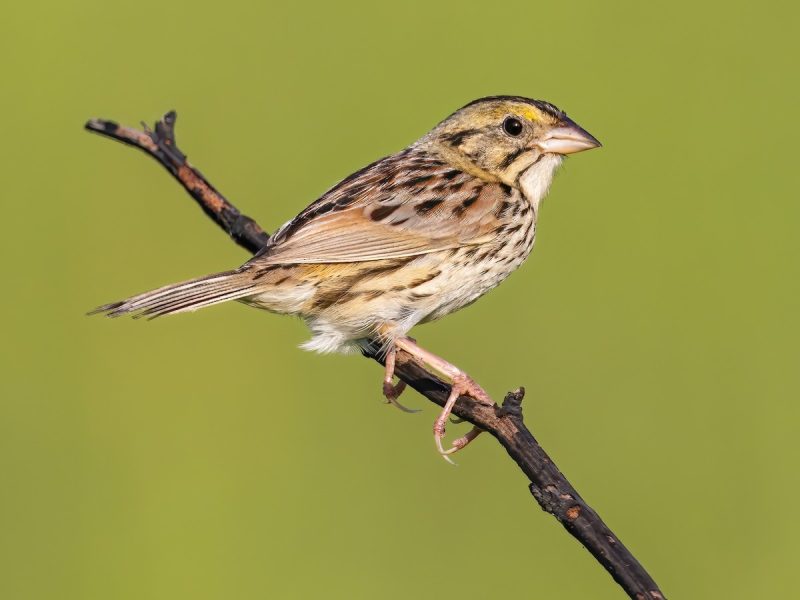
Henslow’s Sparrow is a small, elusive bird recognized by its flat head, olive-toned face, and fine black streaking on a buffy chest. It has a short tail and a large, pale bill. Its plumage blends seamlessly into grassy habitats, providing excellent camouflage from predators and observers.
This sparrow breeds in tall grasslands and wet meadows in the Midwest and eastern United States, often preferring areas with dense vegetation and minimal disturbance. In winter, it migrates to the southeastern U.S., where it continues to inhabit thick grass and brush. Henslow’s Sparrows are shy and rarely seen, often flushed only when nearly stepped on.
They feed on seeds and small insects, foraging mostly on the ground or low in vegetation. A fun fact is that their song is one of the shortest and most peculiar among North American birds—often described as a dry, hiccup-like “tslick,” which can be easily missed unless one is listening attentively in the right habitat.
LeConte’s Sparrow (Ammospiza leconteii)
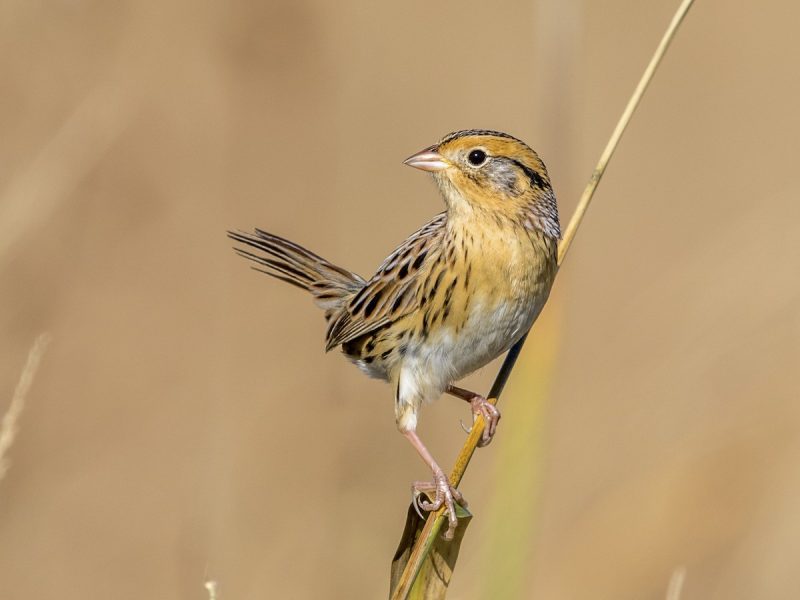
LeConte’s Sparrow is a beautifully marked bird with a buffy orange face, gray crown, and a crisp white belly. It features fine black streaking along its flanks and a pale median stripe on the head. This small sparrow is considered one of the most secretive in North America, making it a prize sighting for birdwatchers.
It breeds in wet meadows, prairie potholes, and grassy sedge fields in central Canada and the north-central United States. During migration and winter, it moves to the southeastern U.S., inhabiting overgrown fields, moist grasslands, and rice fields. LeConte’s Sparrows are elusive and tend to run through grass rather than fly when disturbed.
They feed mostly on grass seeds and small insects, searching low in dense cover. A fun fact is that their nests are well-hidden within clumps of grass and are often hard to find even in intensively studied areas. Their thin, high-pitched song is usually delivered from deep within cover, making detection even more challenging.
Seaside Sparrow (Ammospiza maritima)
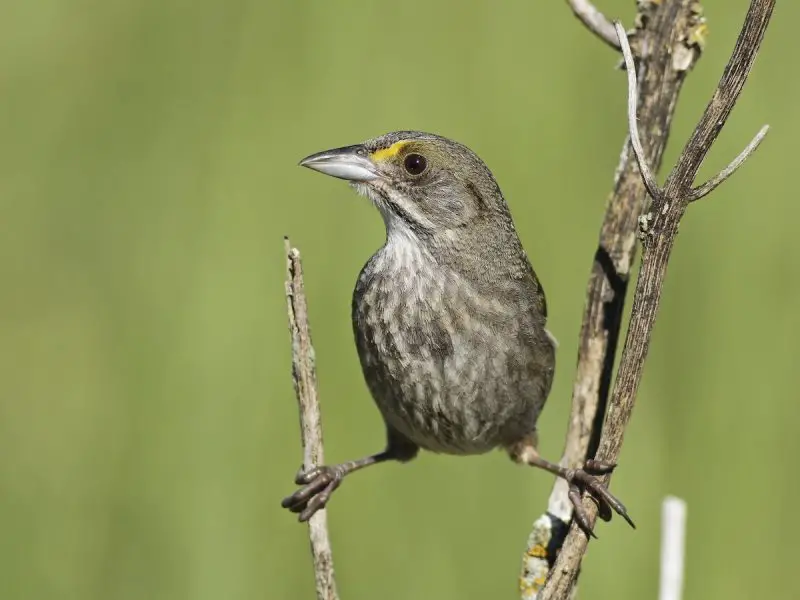
The Seaside Sparrow is a medium-sized bird with a dark gray head, olive back, and streaked underparts. Its distinctive yellow spot in front of the eyes and a heavy bill help identify it. Its plumage blends well with the marsh vegetation it calls home, making it challenging to spot unless singing from a perch.
This species inhabits salt and brackish marshes along the Atlantic and Gulf Coasts of the United States. It prefers tall Spartina grasses and is especially common in undisturbed coastal wetlands. The Seaside Sparrow is a resident bird in many areas, though some northern populations migrate short distances south in winter.
Its diet includes insects, spiders, and small crustaceans, with seeds supplementing during colder months. A fascinating fact about this sparrow is that different populations—like the Dusky Seaside Sparrow, now extinct—have evolved distinct features based on their specific coastal habitats, showing rapid adaptation to microenvironments.
Nelson’s Sparrow (Ammospiza nelsoni)
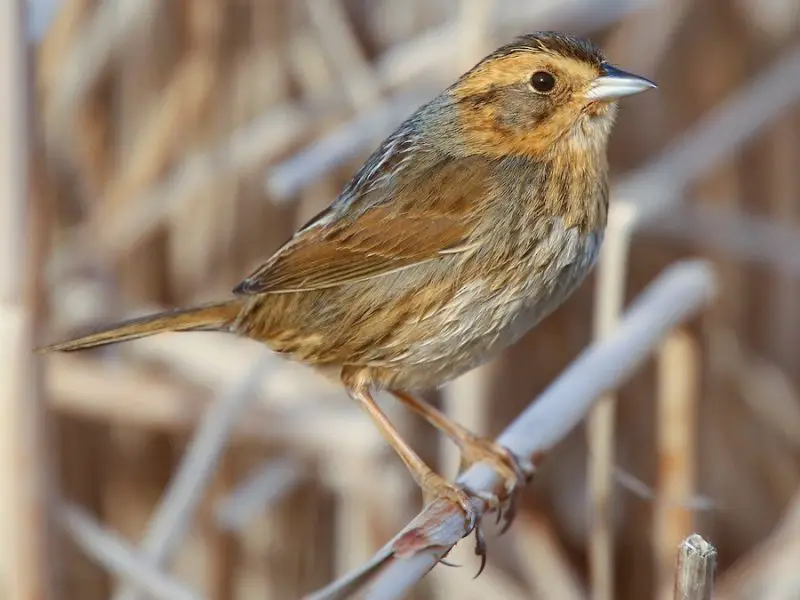
Nelson’s Sparrow is a secretive and beautifully colored bird with a buffy-orange face and breast, grayish crown, and fine streaking down its sides. Its short tail and round body give it a compact appearance. The contrast of soft colors on its face makes it one of the most attractive sparrows in North America.
It breeds in wet, grassy marshes across central Canada and the northern U.S., especially near freshwater or brackish coasts. In winter, it migrates to coastal salt marshes from the southeastern U.S. to Texas. These birds are typically low foragers, walking through thick grasses and often remaining hidden unless flushed.
Their diet consists of insects, aquatic invertebrates, and some seeds. They build well-concealed nests close to the ground. A fun fact is that males have a surprisingly weak and short song, often described as a “hiss-slick” or whispery buzz, which can be difficult to detect in a breezy marshland environment.
Saltmarsh Sparrow (Ammospiza caudacuta)
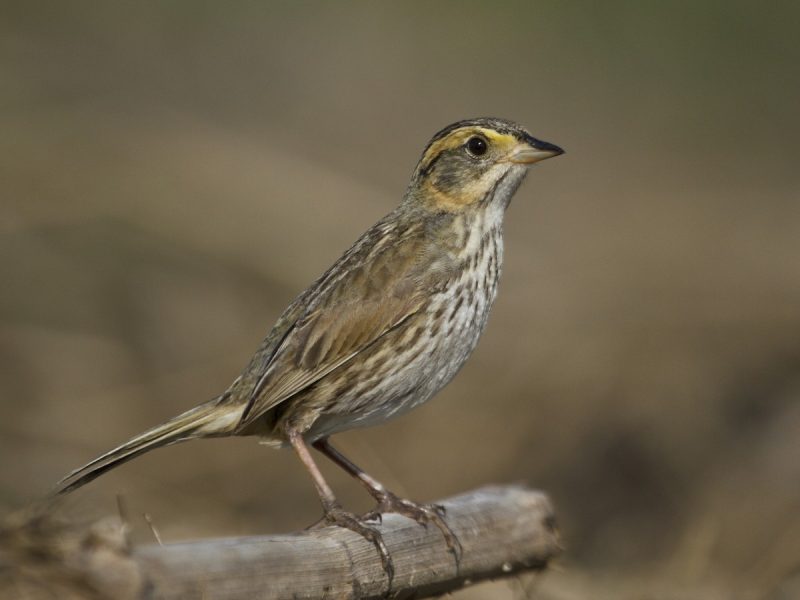
The Saltmarsh Sparrow is a slim, cryptically colored bird with a finely streaked breast, orange face, and gray cheeks. It has a relatively long, pointed tail and blends perfectly into the grassy tidal marshes where it lives. This species is closely related to Nelson’s Sparrow but more coastal in range and habits.
It breeds exclusively in the salt marshes along the northeastern Atlantic coast of the United States, from Maine to the mid-Atlantic. The Saltmarsh Sparrow depends on high-tide cycles for nesting success, as its low-ground nests are vulnerable to flooding. During migration and winter, it remains in coastal marshes farther south.
These birds primarily eat insects, marine invertebrates, and some seeds. They are stealthy foragers and rarely fly unless disturbed. A remarkable fact is that Saltmarsh Sparrows are among the few bird species with no territorial defense; males do not defend nesting areas and may mate with multiple females in a season.
Vesper Sparrow (Pooecetes gramineus)
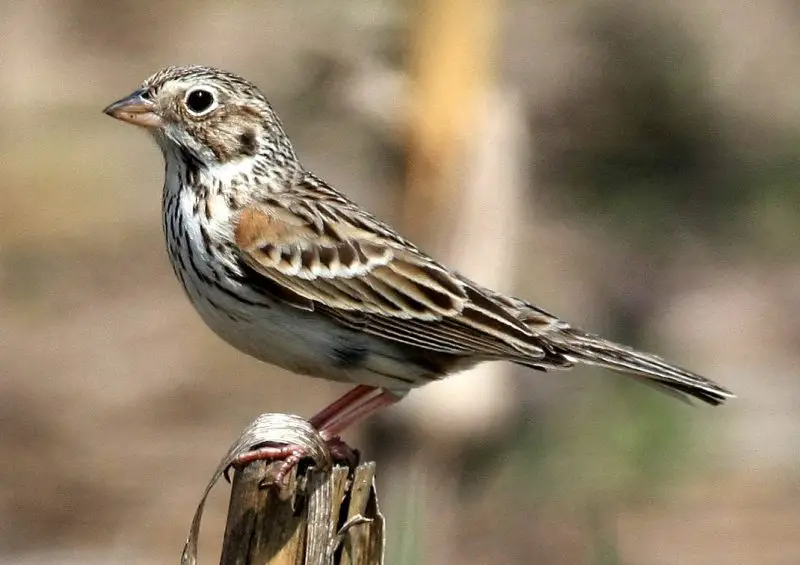
The Vesper Sparrow is a fairly large sparrow with a streaky brown back, white outer tail feathers, and a pale eye ring. Its subtly beautiful plumage helps it blend into open grassy environments. It gets its name from its habit of singing at dusk—like a vesper prayer—when most other birds are quiet.
It breeds in open grasslands, pastures, and agricultural fields across much of North America. Vesper Sparrows are ground-nesters and are often seen perched on fence posts or utility wires. In winter, they migrate to the southern U.S. and parts of Mexico, favoring dry, open spaces.
Their diet includes seeds, grains, and insects, especially grasshoppers and beetles during the breeding season. A fun fact is that Vesper Sparrows sing a sweet, melodic song that includes two introductory notes followed by a series of trills, making it one of the more musical sparrow species.
Field Sparrow (Spizella pusilla)
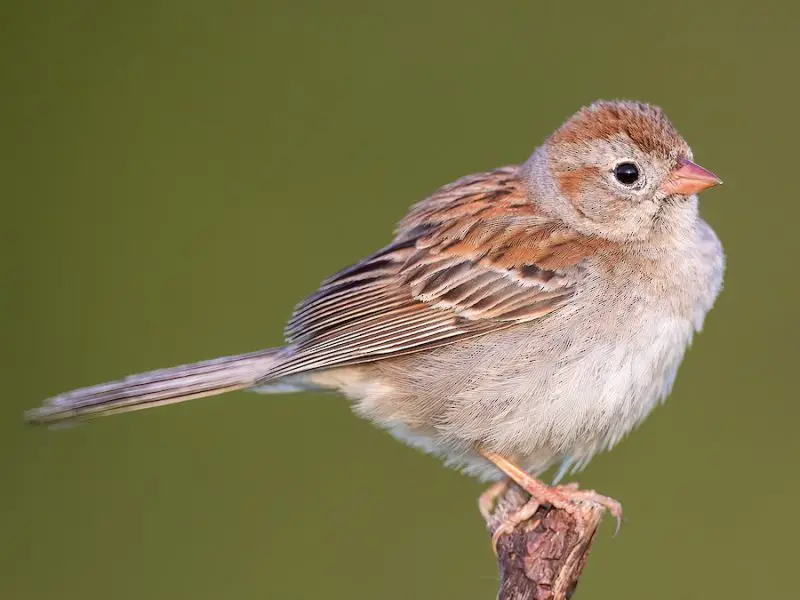
The Field Sparrow is a small, delicate bird with a plain face, pink bill, and rusty crown. It lacks bold streaking and has a clear gray breast and fine white eye ring. Its simple, clean plumage and sweet song give it a gentle presence in open, shrubby habitats.
It inhabits old fields, overgrown pastures, and woodland edges in the eastern and central U.S. Unlike more urban sparrows, the Field Sparrow prefers quiet, brushy areas and avoids heavily developed zones. It is a year-round resident in southern parts of its range but migrates short distances in the north.
Field Sparrows feed on seeds and small insects, foraging on the ground in open patches. A fun fact is their song—a series of accelerating whistles that sounds like a bouncing ball coming to a stop—is one of the most cheerful and recognizable of early spring in rural areas.
Chipping Sparrow (Spizella passerina)
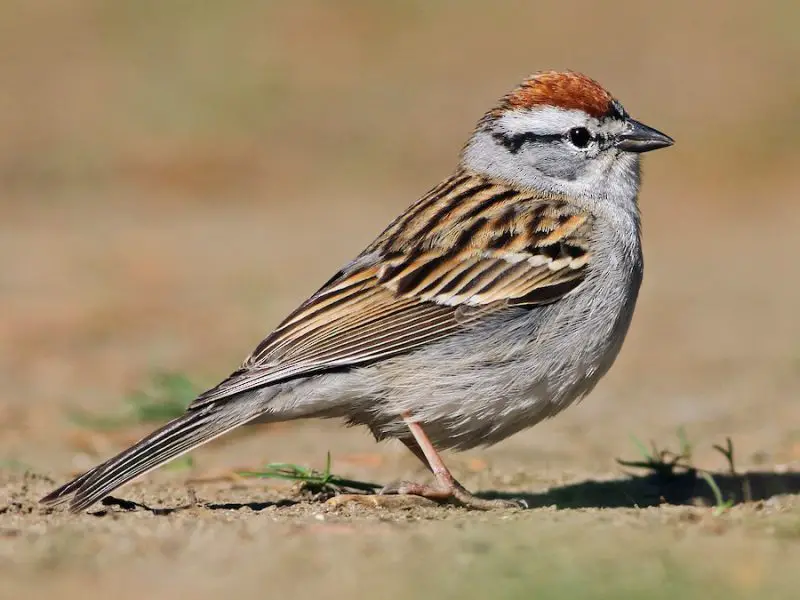
The Chipping Sparrow is a slender, medium-small sparrow with a bright rufous crown, clean gray underparts, and a distinct black line through the eye. During the breeding season, its sharp contrast in head pattern is very recognizable. In winter, its plumage becomes duller, blending more easily into its environment.
It breeds across much of North America in open woodlands, suburban yards, and parks, especially where conifers are present. Chipping Sparrows are migratory, spending winters in the southern U.S., Mexico, and Central America. They often gather in flocks outside of breeding season and forage on the ground for food.
Their diet consists mainly of seeds and small insects. During nesting season, they build tidy, open cup nests in shrubs or trees. A fun fact is that despite their small size, Chipping Sparrows are bold singers, delivering a fast, dry trill that sounds a bit like a sewing machine—making them easy to detect by sound.
Clay-colored Sparrow (Spizella pallida)
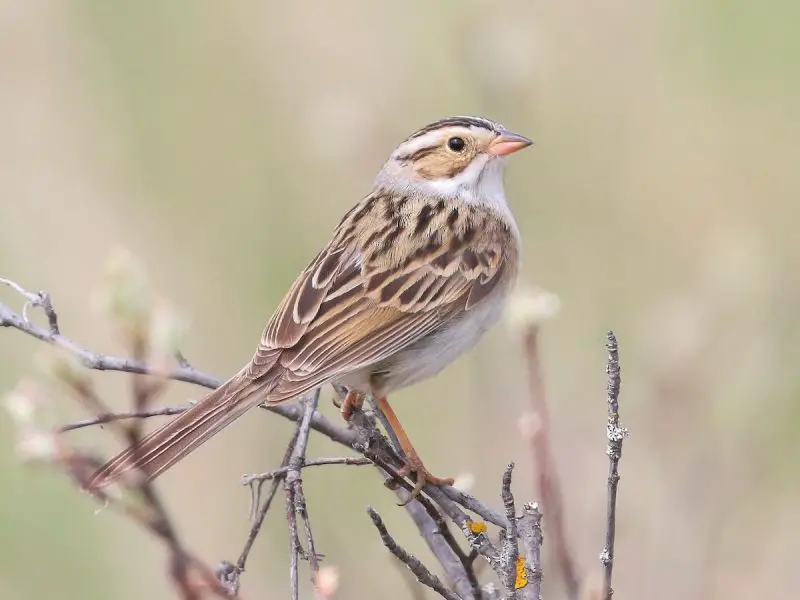
The Clay-colored Sparrow is a small, pale sparrow with a light brown crown, gray nape, and a neat black mustache stripe. It lacks bold streaking, making its plumage appear cleaner and more defined than many other sparrows. Its subtle but distinct facial markings aid in identification.
This species breeds in shrubby grasslands and open woodland edges across central Canada and the north-central U.S. In winter, it migrates to northern Mexico and parts of the southwestern U.S. Clay-colored Sparrows are often seen perched on small shrubs while singing their buzzy, insect-like song.
They feed primarily on seeds and insects, especially during the breeding season. A fun fact is that the Clay-colored Sparrow is a relatively recent range expander—its breeding range has spread eastward over the last century as abandoned farmland and brushy areas have increased, creating new habitats.
Brewer’s Sparrow (Spizella breweri)
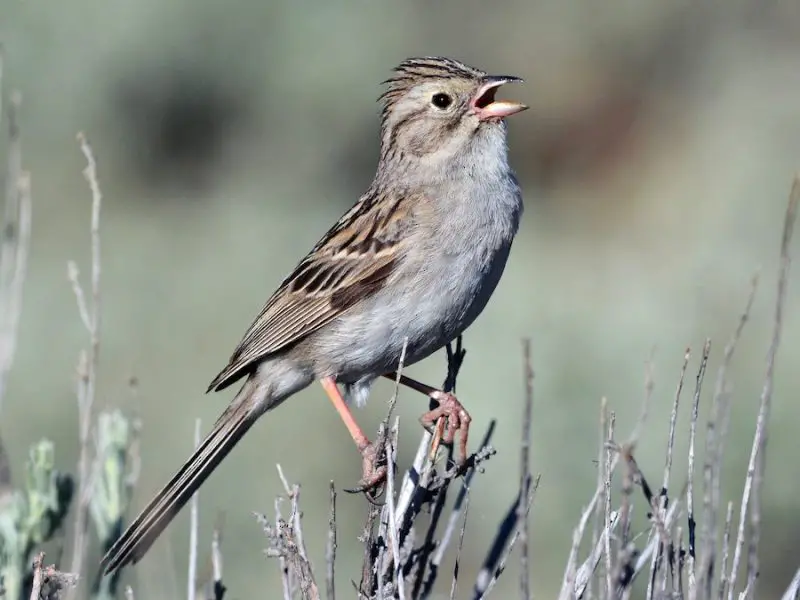
Brewer’s Sparrow is the smallest sparrow in North America and is subtly colored with fine streaks, a pale gray face, and a thin white eye ring. Its understated plumage makes it well-camouflaged in the arid shrublands it inhabits. This bird is often more easily heard than seen.
It breeds in the sagebrush steppe and open dry habitats of the western U.S. and southwestern Canada. These sparrows are highly dependent on sagebrush ecosystems and migrate to desert areas in the southwestern U.S. and Mexico for winter. They typically nest low in shrubs and are difficult to spot outside the breeding season.
Their diet includes insects, spiders, and seeds. Brewer’s Sparrows are known for their long, complex songs, which they sing from high perches in the sagebrush. A fun fact is that their vocal repertoire is among the most varied of any sparrow, and individual males can sing over a hundred different song types.
Lark Sparrow (Chondestes grammacus)
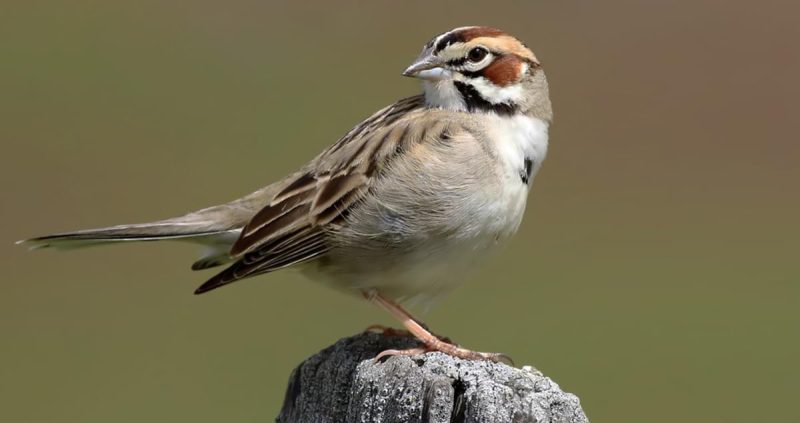
The Lark Sparrow stands out among sparrows with its bold facial pattern, chestnut cheek patches, black mustache stripe, and central chest spot. Its white tail edges and streak-free underparts add to its striking appearance. It’s a larger and more colorful sparrow than most of its relatives.
It breeds in open grassy habitats with scattered trees or shrubs, often in the central and western U.S. Lark Sparrows prefer habitats with bare ground for foraging and low vegetation for nesting. In winter, they migrate to Mexico and the southern U.S., favoring dry, open areas.
They forage for seeds and insects, often walking on the ground in search of food. A fun fact about Lark Sparrows is their courtship behavior—males perform a ground dance with fanned tails, extended wings, and hopping displays to impress females, which is quite elaborate for a sparrow.
Black-throated Sparrow (Amphispiza bilineata)

The Black-throated Sparrow is a striking desert species known for its sharp black throat patch and bold white facial stripes. Its gray back and clean white belly provide contrast to its dark markings, making it one of the most visually distinctive sparrows in North America.
It inhabits arid and semi-arid regions of the southwestern U.S. and northern Mexico, favoring rocky slopes, desert scrub, and open canyons. Unlike many sparrows, it often remains in the same region year-round, enduring hot summers and mild winters in the desert landscape.
These sparrows feed primarily on seeds, supplemented by insects during the breeding season. They often forage on the ground or low vegetation. A fun fact is that the Black-throated Sparrow has a pleasant, melodic song—often described as bell-like—which contrasts with the harsh, buzzy songs of many other sparrows.
Canyon Towhee (Melozone fusca)
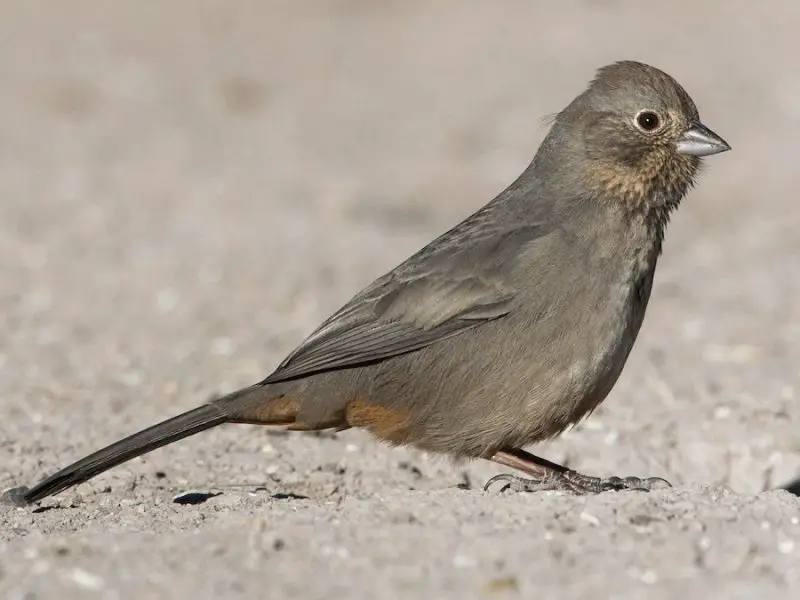
The Canyon Towhee is a large, chunky sparrow with warm brown upperparts and a plain, buffy belly. Its head is rounded with a long tail and a slightly curved bill. Compared to other towhees, it has a more uniform and less streaked appearance, blending well with rocky canyon habitats.
This species is found primarily in arid and semi-arid regions of the southwestern United States and northern Mexico. It prefers canyon bottoms, rocky slopes, and desert scrub, often near water sources. Canyon Towhees are generally resident birds, staying in their range year-round.
They feed mostly on seeds, fruits, and insects, foraging on the ground by scratching leaf litter or soil. A fun fact about Canyon Towhees is that they sometimes mimic the songs of other birds, adding variety to their own calls in the desert soundscape.
Spotted Towhee (Pipilo maculatus)
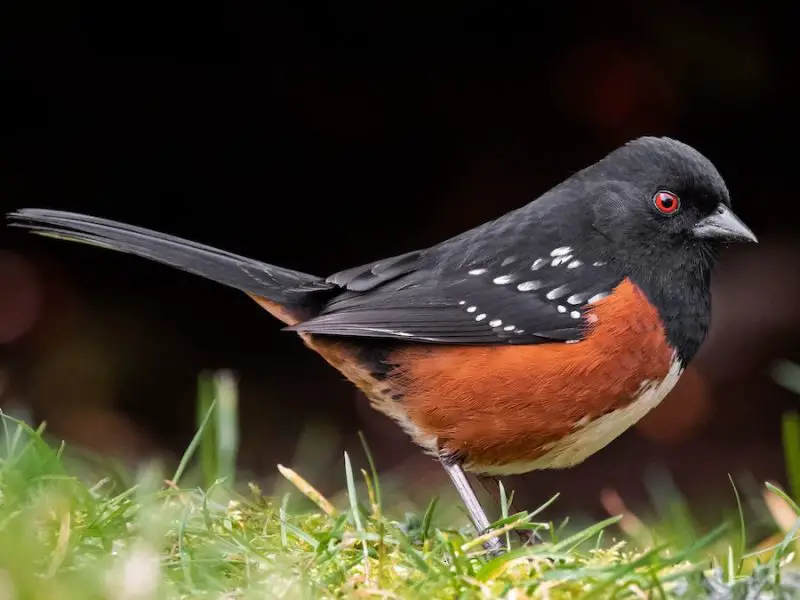
The Spotted Towhee is a striking bird with a black head, chest, and upperparts contrasted by white spots on its wings and back. Its bright rufous sides and white belly make it unmistakable. This sparrow’s bold coloration and loud song make it one of the most recognizable towhees in western North America.
It inhabits dense shrubby areas, forest edges, and brushy undergrowth from southern Canada down through the western United States and into Mexico. It prefers habitats with thick cover for nesting and foraging. Spotted Towhees are mostly resident but some northern populations migrate south in winter.
Their diet includes seeds, berries, and insects, which they find by scratching leaf litter with both feet—a behavior known as “double-scratching.” A fun fact is that Spotted Towhees can produce a variety of songs and calls, and males often use their vocal skills to defend territories and attract mates.
Eastern Towhee (Pipilo erythrophthalmus)
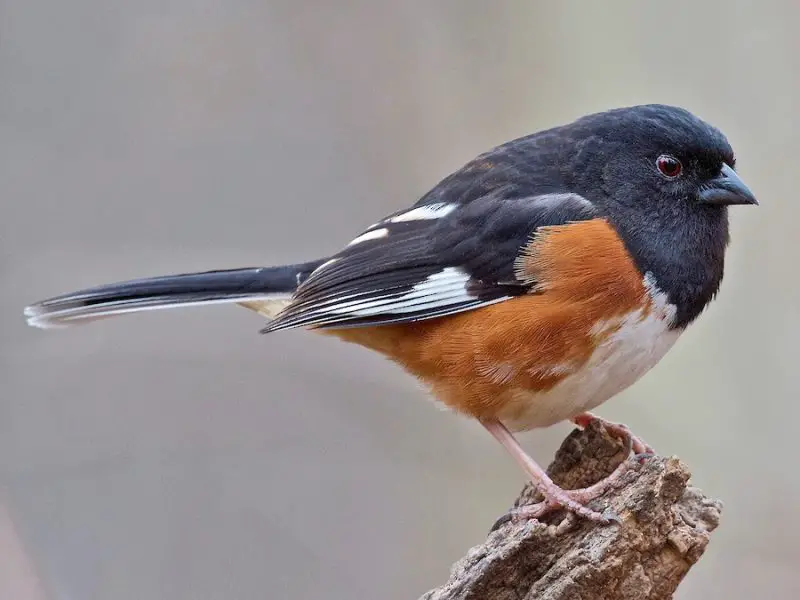
The Eastern Towhee resembles the Spotted Towhee but has a more subtle appearance, with a black head and upperparts, rufous sides, and a white belly. One key identifying feature is its bright red eyes, distinguishing it from its western cousin. It has a robust build and a long tail with white spots on the outer feathers.
This species is found in the eastern United States, inhabiting dense thickets, forest edges, and overgrown fields. Eastern Towhees prefer habitats with dense underbrush where they can forage and nest. They are mostly non-migratory but may move short distances during winter.
Their diet consists mainly of seeds, insects, and berries, often foraged on the forest floor using their characteristic double-scratch method. A fun fact is that Eastern Towhees are known for their loud, two-part song that sounds like “drink-your-tea,” a phrase often used by birders to remember their call.
Green-tailed Towhee (Pipilo chlorurus)
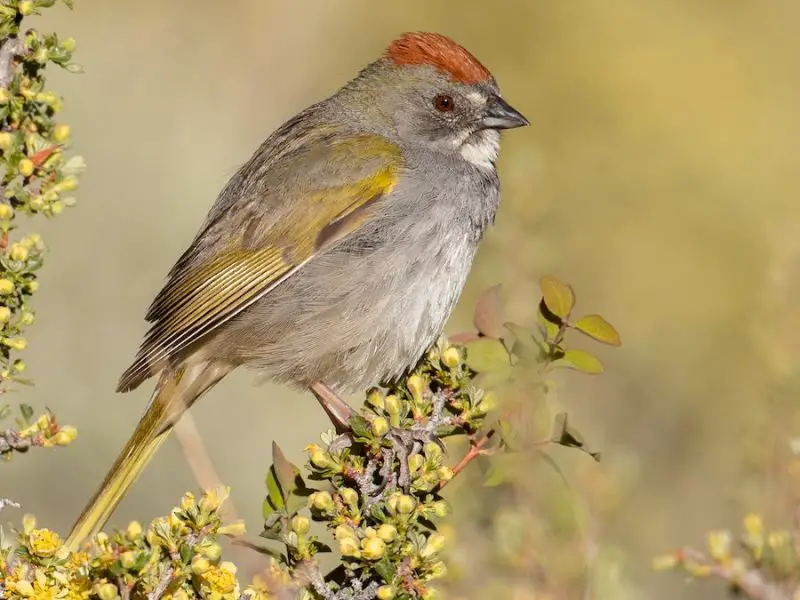
The Green-tailed Towhee is a subtly beautiful sparrow with olive-green upperparts, a gray face and chest, and warm orange flanks. Its greenish tail with white edges gives the species its name. This towhee has a more muted coloration compared to other towhees but is easily recognized by its unique tail color.
It breeds in shrubby mountain habitats in the western United States and southwestern Canada, often above the sagebrush and at mid to high elevations. In winter, it migrates to lower elevations or southern regions with similar shrubby vegetation.
Their diet includes seeds, berries, and insects, foraged primarily on the ground in dense brush. A fun fact about Green-tailed Towhees is that they can be surprisingly shy and secretive, often remaining hidden in thick cover despite their distinctive song.
Rufous-crowned Sparrow (Aimophila ruficeps)

The Rufous-crowned Sparrow is a small, ground-dwelling bird with a distinctive rusty crown contrasting sharply with its gray-brown back and pale underparts. Its subtle streaking and compact build help it blend into dry, rocky habitats. It has a thin, pointed bill suited for its insectivorous diet.
This species is found in the southwestern United States and northern Mexico, preferring arid scrublands, rocky slopes, and chaparral environments. It is a resident bird and rarely migrates, relying on local resources year-round.
The Rufous-crowned Sparrow feeds mainly on insects and spiders but also takes seeds. It forages by hopping along the ground and scratching leaf litter. A fun fact is that its song is a simple, clear whistle that it often sings from low shrubs or rocky perches, providing a melodious soundtrack to desert landscapes.
Bachman’s Sparrow (Peucaea aestivalis)
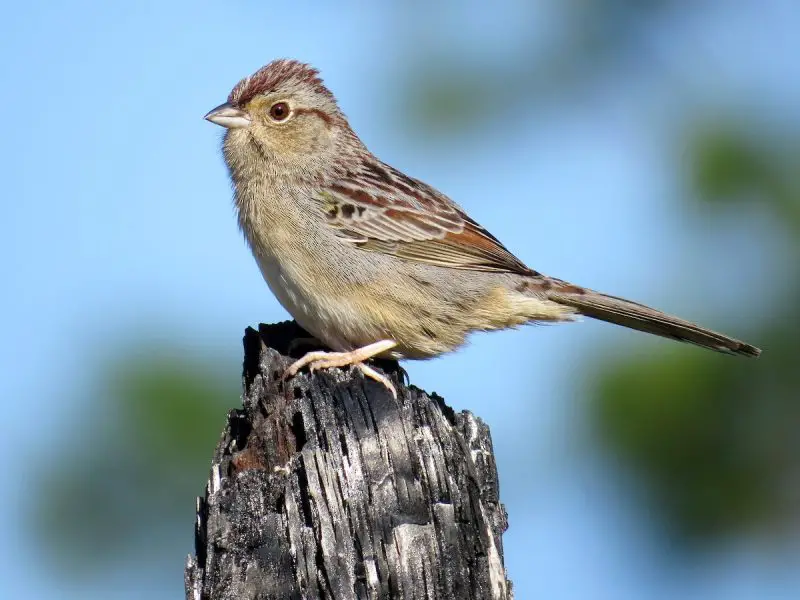
Bachman’s Sparrow is a small, slim sparrow with a warm brown and gray plumage, featuring fine streaks on its back and a pale breast with subtle streaking. It has a distinctive long tail and a short, slightly curved bill. This bird’s understated colors help it blend into the pine forests and grassy understory where it lives.
This species is native to the southeastern United States, primarily in pine savannas and open woodlands with a thick ground layer of grasses and shrubs. Bachman’s Sparrows rely on fire-maintained habitats, so regular controlled burns help maintain their environment. They are non-migratory and tend to stay in the same area year-round.
Their diet consists mostly of seeds and insects, which they forage for on the ground. A fun fact about Bachman’s Sparrow is that its song is a clear, musical whistle repeated in a rhythmic pattern, often described as a “sweet-sweet-sweet, tea-kettle, tea-kettle” sound.
Cassin’s Sparrow (Peucaea cassinii)
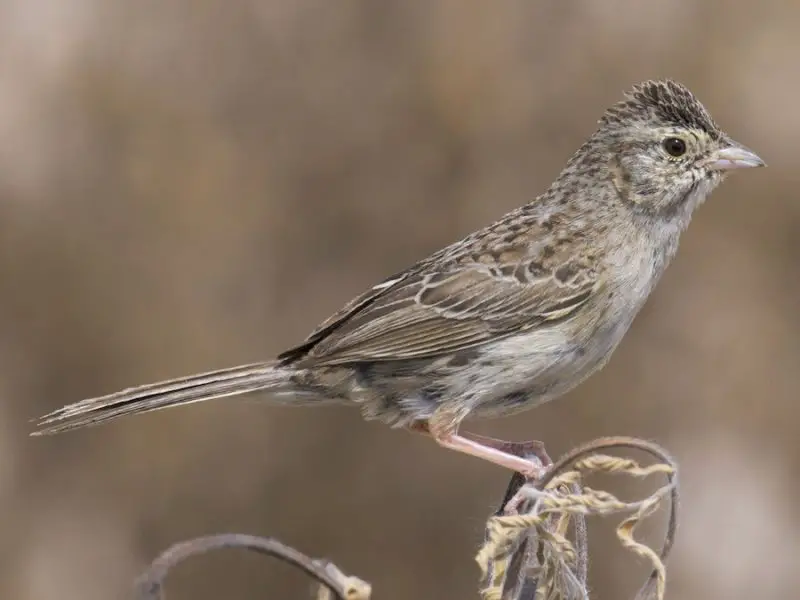
Cassin’s Sparrow is a medium-sized sparrow with warm brown upperparts streaked with black and a pale, unstreaked breast. It has a rounded head and a fairly long tail with white edges. This species is known for its slender appearance and subtle, earthy coloration that blends well with dry grasslands.
It inhabits the dry, open grasslands and shrublands of the southwestern United States and northern Mexico. Cassin’s Sparrows prefer flat, sparsely vegetated areas and tend to avoid dense woodlands. They are mostly resident but some may move locally in response to seasonal conditions.
Their diet mainly consists of seeds and insects, which they forage for on the ground. Cassin’s Sparrow is famous for its beautiful, complex song delivered during long, hovering flight displays, which birders often seek out during breeding season.
Botteri’s Sparrow (Peucaea botterii)
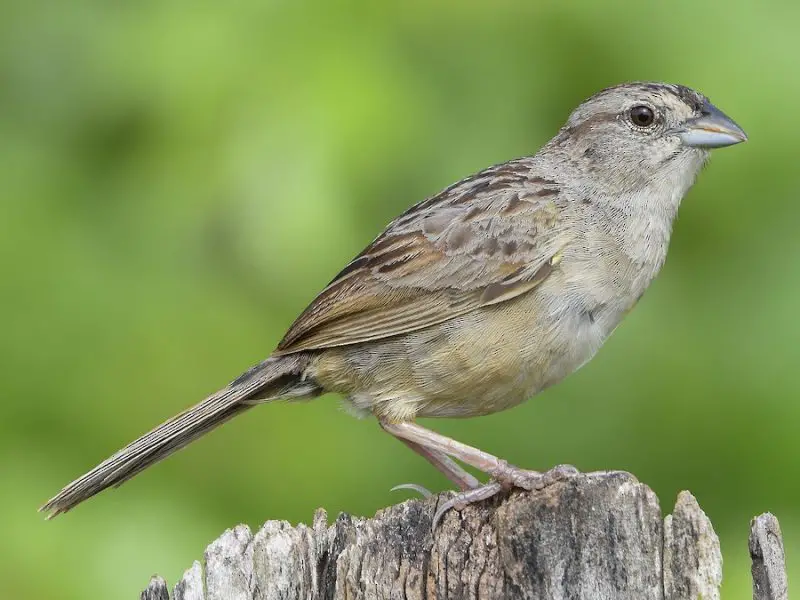
Botteri’s Sparrow is a medium-sized sparrow with warm brown and gray plumage, characterized by fine streaking on the back and a pale, unstreaked chest. It has a long tail and a slender build. This species’ subtle tones allow it to blend seamlessly into grassland habitats.
It is found primarily in arid grasslands and shrublands in northern Mexico and the southwestern United States. Botteri’s Sparrows prefer habitats with tall grasses and scattered shrubs and are mostly resident, rarely migrating far.
Their diet consists mainly of seeds and insects. A fun fact is that Botteri’s Sparrow’s song is a melodious, repetitive whistle, similar to that of the Cassin’s Sparrow, but it is usually heard from concealed perches rather than in flight displays.
Five-striped Sparrow (Amphispizopsis quinquestriata)

The Five-striped Sparrow is a distinctive sparrow with striking facial patterns, including five bold black and white stripes across its head and a grayish-brown body. It has a stout body and a thick bill adapted for seed eating. Its unique head markings make it one of the easiest sparrows to identify.
This rare species is found in the mountainous canyons and scrub habitats of northern Mexico and extreme southern Arizona. It prefers rocky slopes with dense vegetation and is typically secretive and difficult to observe in the wild.
Their diet primarily includes seeds and insects, foraged from the ground and low shrubs. A fun fact about the Five-striped Sparrow is that it was once considered extremely rare but has become more regularly observed thanks to targeted conservation efforts and habitat protection.
Abert’s Towhee (Melozone aberti)
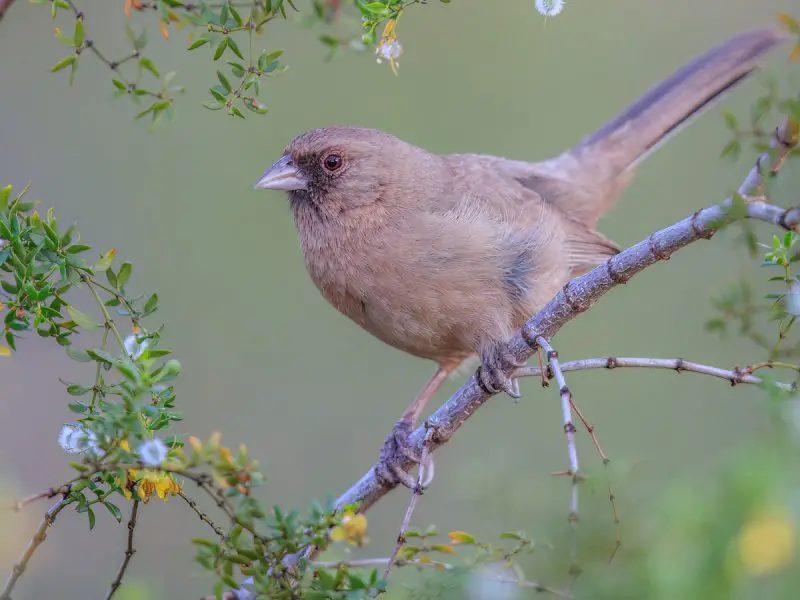
Abert’s Towhee is a large, chunky bird with mostly brown upperparts and pale underparts. It has a distinctive long tail and a relatively plain face compared to other towhees. Its thick bill and robust body suit its ground-foraging lifestyle.
This species inhabits the desert scrub and riparian woodlands of the southwestern United States and northern Mexico. It is usually found near water sources in arid landscapes and is known for its shy behavior, often staying low in dense brush.
Abert’s Towhee feeds mostly on seeds, insects, and small fruits, often scratching leaf litter for food. A fun fact is that unlike many towhees, Abert’s Towhee often forages quietly, relying more on stealth than loud double-scratching to find food.
Rufous-winged Sparrow (Peucaea carpalis)
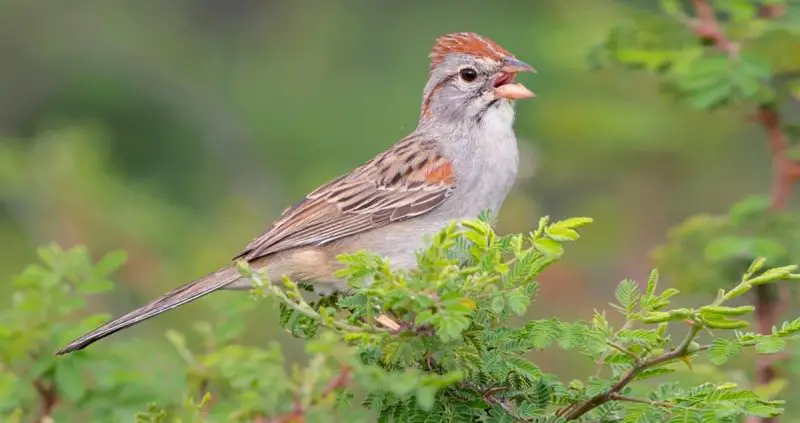
The Rufous-winged Sparrow is a medium-sized sparrow notable for its striking rusty-orange wing patches contrasted against grayish-brown body feathers. Its face features a subtle white eye ring and a pale throat, with an overall warm-toned plumage that blends well in its desert habitat. The long tail and slender bill complete its distinctive look.
This species is primarily found in the arid southwestern United States and northern Mexico, favoring dry scrublands and rocky canyons with scattered bushes. It tends to be secretive, often staying low in dense vegetation to avoid predators. The Rufous-winged Sparrow is mostly resident but may move locally depending on rainfall.
Their diet consists mainly of seeds and insects, foraged from the ground and low shrubs. A fun fact about the Rufous-winged Sparrow is that its song is a soft, musical series of whistles and trills, which it often delivers from concealed perches rather than in flight.
Harris’s Sparrow (Zonotrichia querula)
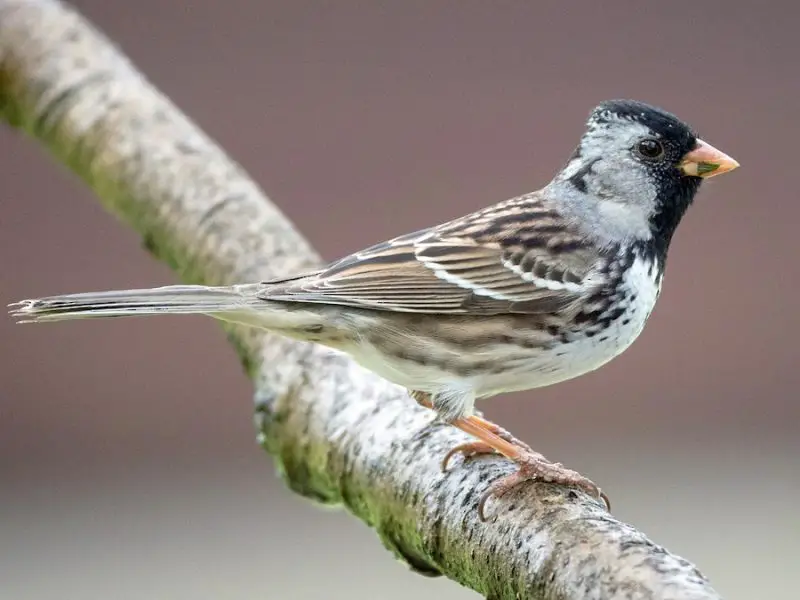
Harris’s Sparrow is the largest sparrow native to North America, easily recognized by its striking black face, throat, and crown, contrasted with a gray nape and brownish wings. Its bulky build and distinctive black bib make it stand out among other sparrows. Juveniles lack the full black facial markings and are more muted in color.
This species breeds in the boreal forests and shrublands of central Canada, migrating to the central and northern United States during winter. Harris’s Sparrow favors open woodlands, forest edges, and brushy areas during its non-breeding season.
Their diet is diverse, including seeds, berries, and insects, which they forage on the ground or in low vegetation. A fun fact is that Harris’s Sparrow is known for its melodious, clear whistle that often sounds like a slurred “whoo-eet,” making it a favorite among birdwatchers.
Golden-crowned Sparrow (Zonotrichia atricapilla)
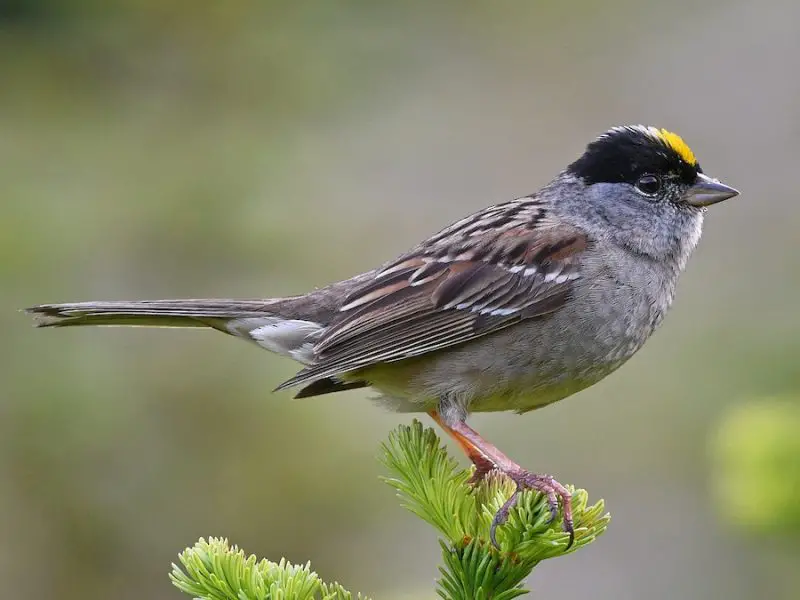
The Golden-crowned Sparrow is known for the bright yellow or golden patch on its crown, bordered by black stripes that create a bold facial pattern. Its overall plumage is gray-brown with streaks on the back and pale underparts. The distinct crown patch is especially vivid during the breeding season.
This species breeds in the coastal and mountainous regions of Alaska and western Canada, migrating to the Pacific coast of the United States for winter. It inhabits shrublands, forest edges, and brushy habitats near water during migration and winter.
Golden-crowned Sparrows primarily feed on seeds and insects, often foraging on the ground among leaf litter. A fun fact is that their catchy, whistled song is often described as a “sweet, clear series of whistles,” which they use to communicate in dense habitats.
Baird’s Sparrow (Centronyx bairdii)
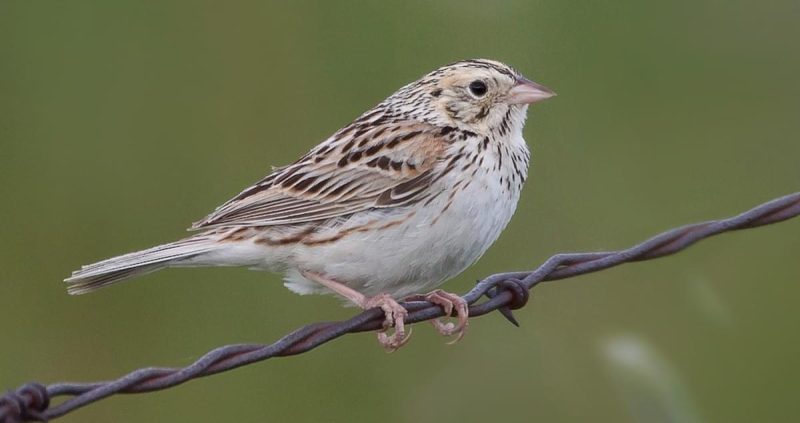
Baird’s Sparrow is a small, streaky sparrow with a warm buffy coloration and fine streaking on its back and breast. It has a subtle facial pattern with a light eyebrow stripe and a relatively plain face compared to other sparrows. Its short tail and slim bill suit its grassland lifestyle.
This species breeds in the northern Great Plains of the United States and Canada, favoring native prairie grasslands with tall grasses and sparse shrubs. Baird’s Sparrows are migratory, wintering in the southwestern U.S. and northern Mexico in open shrub and grass habitats.
Their diet consists mainly of seeds and insects, foraged from the ground. A fun fact is that Baird’s Sparrow is highly dependent on intact prairie ecosystems and is considered an indicator species for prairie health, making conservation efforts crucial for its survival.

